Understanding Consultancy Process in Learning and Development
VerifiedAdded on 2023/04/04
|21
|4823
|444
AI Summary
This document provides an overview of the meaning of consultancy and the stages in the consulting process in a learning and development context. It also compares and contrasts different examples of consultancy in the business world.
Contribute Materials
Your contribution can guide someone’s learning journey. Share your
documents today.
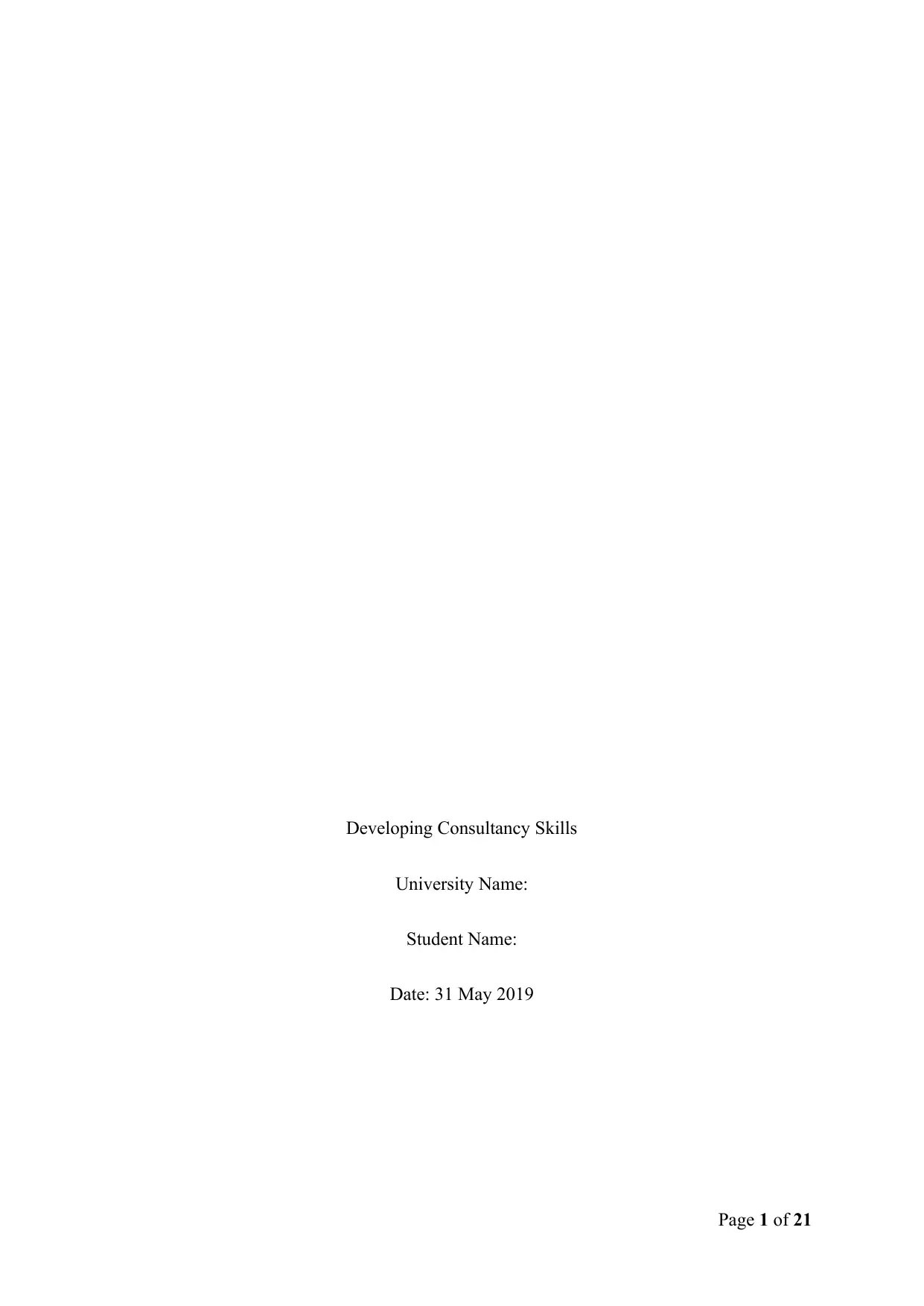
Developing Consultancy Skills
University Name:
Student Name:
Date: 31 May 2019
Page 1 of 21
University Name:
Student Name:
Date: 31 May 2019
Page 1 of 21
Secure Best Marks with AI Grader
Need help grading? Try our AI Grader for instant feedback on your assignments.
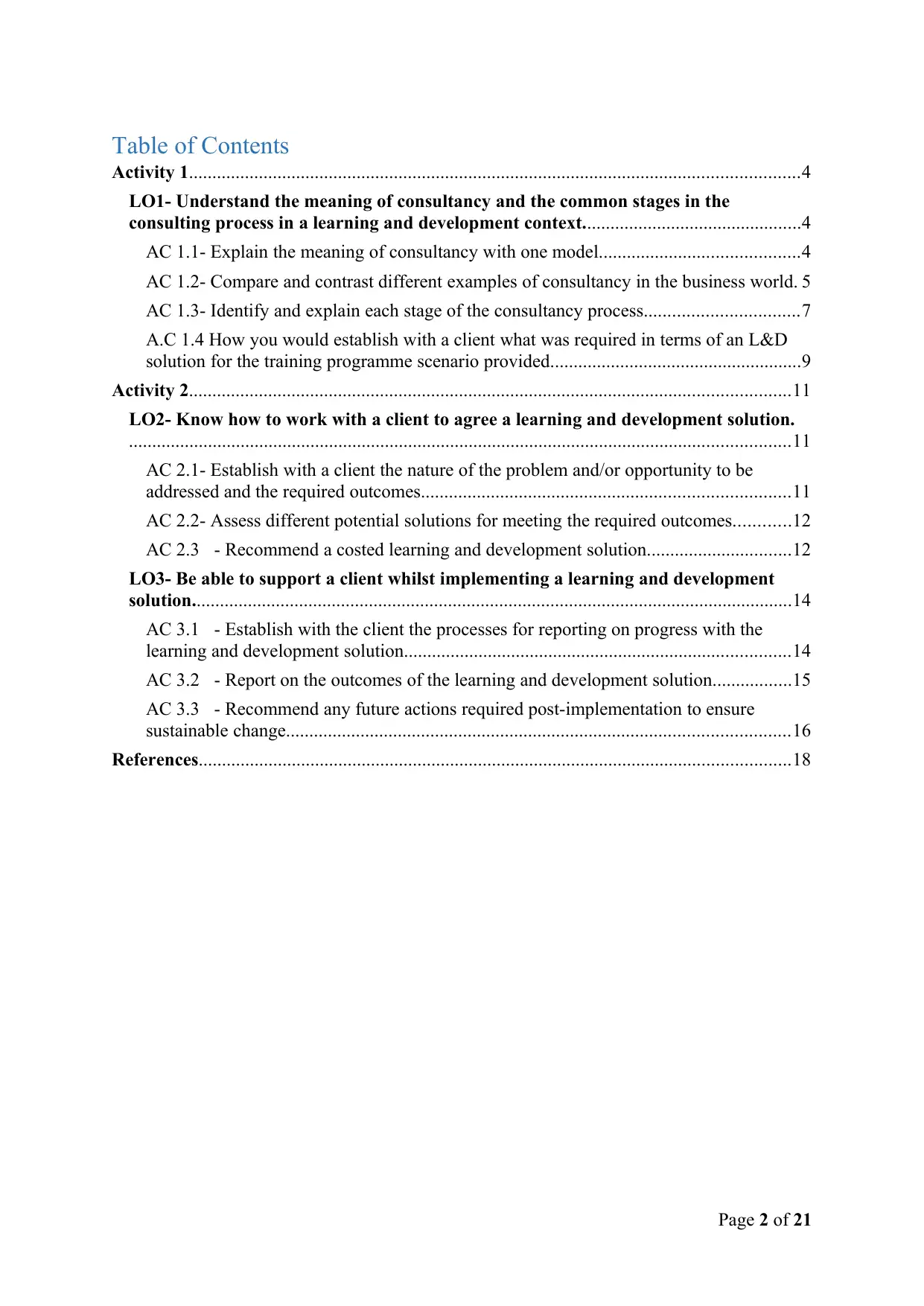
Table of Contents
Activity 1...................................................................................................................................4
LO1- Understand the meaning of consultancy and the common stages in the
consulting process in a learning and development context...............................................4
AC 1.1- Explain the meaning of consultancy with one model...........................................4
AC 1.2- Compare and contrast different examples of consultancy in the business world. 5
AC 1.3- Identify and explain each stage of the consultancy process.................................7
A.C 1.4 How you would establish with a client what was required in terms of an L&D
solution for the training programme scenario provided......................................................9
Activity 2.................................................................................................................................11
LO2- Know how to work with a client to agree a learning and development solution.
..............................................................................................................................................11
AC 2.1- Establish with a client the nature of the problem and/or opportunity to be
addressed and the required outcomes...............................................................................11
AC 2.2- Assess different potential solutions for meeting the required outcomes............12
AC 2.3 - Recommend a costed learning and development solution...............................12
LO3- Be able to support a client whilst implementing a learning and development
solution.................................................................................................................................14
AC 3.1 - Establish with the client the processes for reporting on progress with the
learning and development solution...................................................................................14
AC 3.2 - Report on the outcomes of the learning and development solution.................15
AC 3.3 - Recommend any future actions required post-implementation to ensure
sustainable change............................................................................................................16
References...............................................................................................................................18
Page 2 of 21
Activity 1...................................................................................................................................4
LO1- Understand the meaning of consultancy and the common stages in the
consulting process in a learning and development context...............................................4
AC 1.1- Explain the meaning of consultancy with one model...........................................4
AC 1.2- Compare and contrast different examples of consultancy in the business world. 5
AC 1.3- Identify and explain each stage of the consultancy process.................................7
A.C 1.4 How you would establish with a client what was required in terms of an L&D
solution for the training programme scenario provided......................................................9
Activity 2.................................................................................................................................11
LO2- Know how to work with a client to agree a learning and development solution.
..............................................................................................................................................11
AC 2.1- Establish with a client the nature of the problem and/or opportunity to be
addressed and the required outcomes...............................................................................11
AC 2.2- Assess different potential solutions for meeting the required outcomes............12
AC 2.3 - Recommend a costed learning and development solution...............................12
LO3- Be able to support a client whilst implementing a learning and development
solution.................................................................................................................................14
AC 3.1 - Establish with the client the processes for reporting on progress with the
learning and development solution...................................................................................14
AC 3.2 - Report on the outcomes of the learning and development solution.................15
AC 3.3 - Recommend any future actions required post-implementation to ensure
sustainable change............................................................................................................16
References...............................................................................................................................18
Page 2 of 21
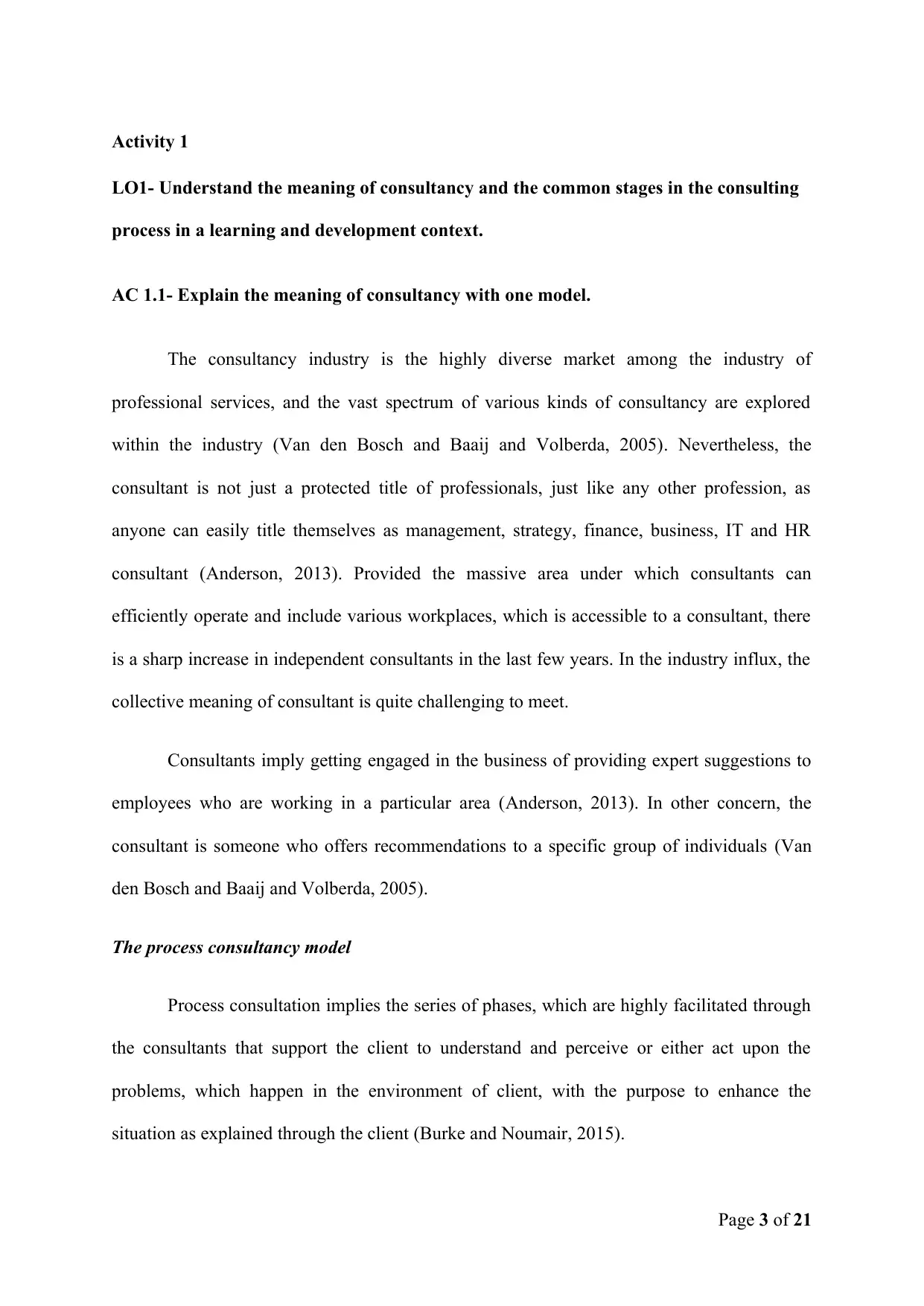
Activity 1
LO1- Understand the meaning of consultancy and the common stages in the consulting
process in a learning and development context.
AC 1.1- Explain the meaning of consultancy with one model.
The consultancy industry is the highly diverse market among the industry of
professional services, and the vast spectrum of various kinds of consultancy are explored
within the industry (Van den Bosch and Baaij and Volberda, 2005). Nevertheless, the
consultant is not just a protected title of professionals, just like any other profession, as
anyone can easily title themselves as management, strategy, finance, business, IT and HR
consultant (Anderson, 2013). Provided the massive area under which consultants can
efficiently operate and include various workplaces, which is accessible to a consultant, there
is a sharp increase in independent consultants in the last few years. In the industry influx, the
collective meaning of consultant is quite challenging to meet.
Consultants imply getting engaged in the business of providing expert suggestions to
employees who are working in a particular area (Anderson, 2013). In other concern, the
consultant is someone who offers recommendations to a specific group of individuals (Van
den Bosch and Baaij and Volberda, 2005).
The process consultancy model
Process consultation implies the series of phases, which are highly facilitated through
the consultants that support the client to understand and perceive or either act upon the
problems, which happen in the environment of client, with the purpose to enhance the
situation as explained through the client (Burke and Noumair, 2015).
Page 3 of 21
LO1- Understand the meaning of consultancy and the common stages in the consulting
process in a learning and development context.
AC 1.1- Explain the meaning of consultancy with one model.
The consultancy industry is the highly diverse market among the industry of
professional services, and the vast spectrum of various kinds of consultancy are explored
within the industry (Van den Bosch and Baaij and Volberda, 2005). Nevertheless, the
consultant is not just a protected title of professionals, just like any other profession, as
anyone can easily title themselves as management, strategy, finance, business, IT and HR
consultant (Anderson, 2013). Provided the massive area under which consultants can
efficiently operate and include various workplaces, which is accessible to a consultant, there
is a sharp increase in independent consultants in the last few years. In the industry influx, the
collective meaning of consultant is quite challenging to meet.
Consultants imply getting engaged in the business of providing expert suggestions to
employees who are working in a particular area (Anderson, 2013). In other concern, the
consultant is someone who offers recommendations to a specific group of individuals (Van
den Bosch and Baaij and Volberda, 2005).
The process consultancy model
Process consultation implies the series of phases, which are highly facilitated through
the consultants that support the client to understand and perceive or either act upon the
problems, which happen in the environment of client, with the purpose to enhance the
situation as explained through the client (Burke and Noumair, 2015).
Page 3 of 21
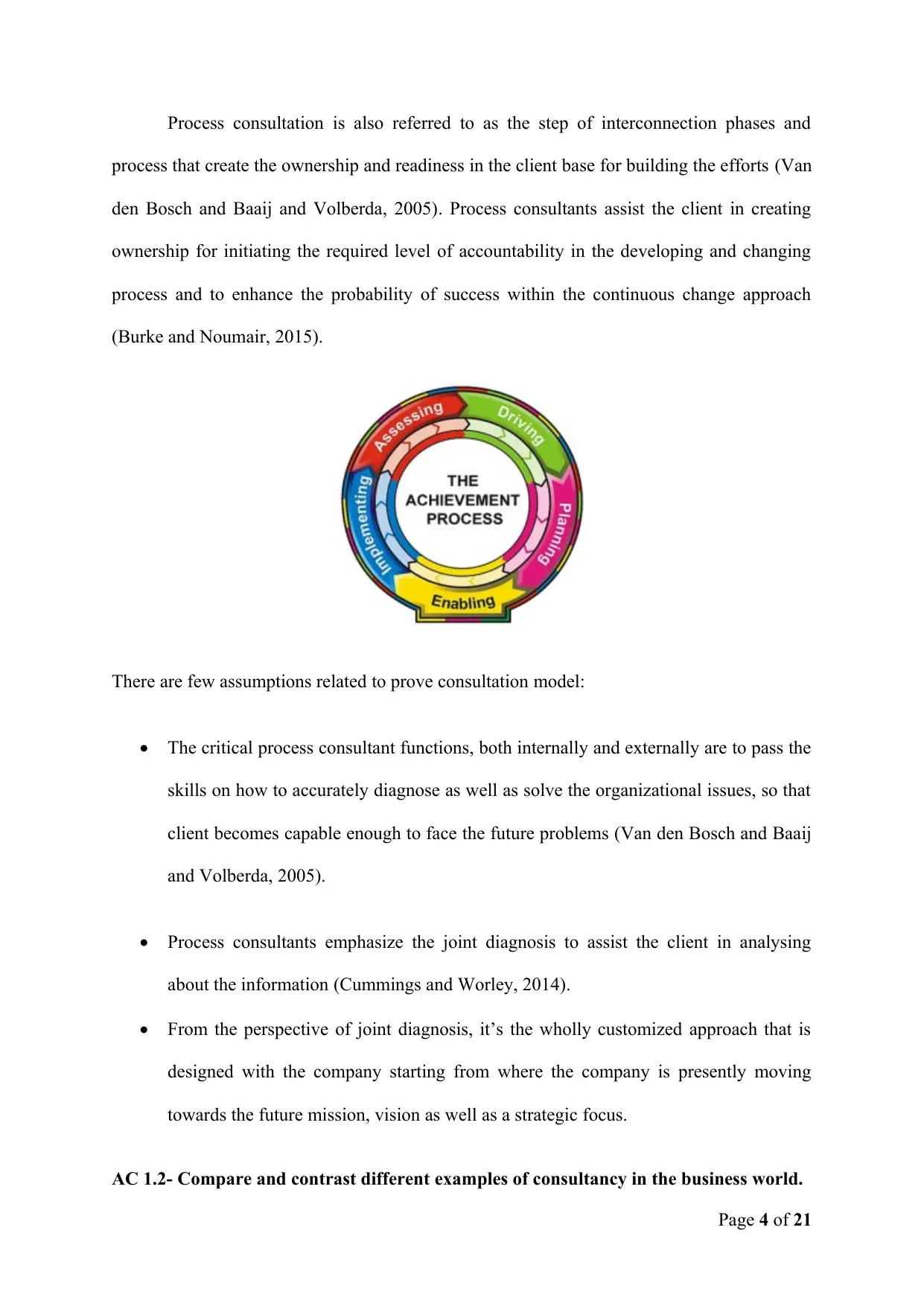
Process consultation is also referred to as the step of interconnection phases and
process that create the ownership and readiness in the client base for building the efforts (Van
den Bosch and Baaij and Volberda, 2005). Process consultants assist the client in creating
ownership for initiating the required level of accountability in the developing and changing
process and to enhance the probability of success within the continuous change approach
(Burke and Noumair, 2015).
There are few assumptions related to prove consultation model:
The critical process consultant functions, both internally and externally are to pass the
skills on how to accurately diagnose as well as solve the organizational issues, so that
client becomes capable enough to face the future problems (Van den Bosch and Baaij
and Volberda, 2005).
Process consultants emphasize the joint diagnosis to assist the client in analysing
about the information (Cummings and Worley, 2014).
From the perspective of joint diagnosis, it’s the wholly customized approach that is
designed with the company starting from where the company is presently moving
towards the future mission, vision as well as a strategic focus.
AC 1.2- Compare and contrast different examples of consultancy in the business world.
Page 4 of 21
process that create the ownership and readiness in the client base for building the efforts (Van
den Bosch and Baaij and Volberda, 2005). Process consultants assist the client in creating
ownership for initiating the required level of accountability in the developing and changing
process and to enhance the probability of success within the continuous change approach
(Burke and Noumair, 2015).
There are few assumptions related to prove consultation model:
The critical process consultant functions, both internally and externally are to pass the
skills on how to accurately diagnose as well as solve the organizational issues, so that
client becomes capable enough to face the future problems (Van den Bosch and Baaij
and Volberda, 2005).
Process consultants emphasize the joint diagnosis to assist the client in analysing
about the information (Cummings and Worley, 2014).
From the perspective of joint diagnosis, it’s the wholly customized approach that is
designed with the company starting from where the company is presently moving
towards the future mission, vision as well as a strategic focus.
AC 1.2- Compare and contrast different examples of consultancy in the business world.
Page 4 of 21
Secure Best Marks with AI Grader
Need help grading? Try our AI Grader for instant feedback on your assignments.

Consultancy business offers suggestions to clients by taking a fee, which supports
them in solving their specific issues or a wide range of issues within a particular area of
business. Consultancy services are offered through consultants, and most of whom achieve
the expertise from their last employment (Van den Bosch and Baaij and Volberda, 2005).
There are few consultants, who are working for big consultancy companies, such as
Anderson consulting that provide expertise in a vast range of business; where else other
consultancy companies are from academic companies with issues associated with research or
either theory; and other consultancies are working as independent contractors and are self-
employed, who provide specialized skills in specific area (Dawson-Shepherd, Kellner and
Neumann, 2013). For instance, the previous stockbroker might come up as financial
consultant; former staff of non-profit company might come up with their fundraising
consultant; computer scientist might come up as computer consultant, and an accountant can
also become tax consultant (Van den Bosch and Baaij and Volberda, 2005).
Consultants support different businesses in exploring as well as implementing the
solutions to a vast area of issues, covering the one related with a start-up business, strategy,
health and safety, communications, manufacturing, technology, environmental compliance,
as well as organizational structure (Nevis, 2013). Along with the operation size and speciality
field, consultants can be divided in various ways. For instance, an advisory consultant tries to
understand the issues and give suggestions to the client, but this process is not part of
implementing the solution (Van den Bosch and Baaij and Volberda, 2005). In contrast to this,
the operational consultant supports the client in the right implementation, and in some
instances, it also manages the implementation without taking the assistance of the client
(Robbins, Judge, Millett and Boyle, 2013).
It is noted that part-time consultants are hired for a full-time job within the area of
marketing expertise. For instance, they also provide services to many other organizations side
Page 5 of 21
them in solving their specific issues or a wide range of issues within a particular area of
business. Consultancy services are offered through consultants, and most of whom achieve
the expertise from their last employment (Van den Bosch and Baaij and Volberda, 2005).
There are few consultants, who are working for big consultancy companies, such as
Anderson consulting that provide expertise in a vast range of business; where else other
consultancy companies are from academic companies with issues associated with research or
either theory; and other consultancies are working as independent contractors and are self-
employed, who provide specialized skills in specific area (Dawson-Shepherd, Kellner and
Neumann, 2013). For instance, the previous stockbroker might come up as financial
consultant; former staff of non-profit company might come up with their fundraising
consultant; computer scientist might come up as computer consultant, and an accountant can
also become tax consultant (Van den Bosch and Baaij and Volberda, 2005).
Consultants support different businesses in exploring as well as implementing the
solutions to a vast area of issues, covering the one related with a start-up business, strategy,
health and safety, communications, manufacturing, technology, environmental compliance,
as well as organizational structure (Nevis, 2013). Along with the operation size and speciality
field, consultants can be divided in various ways. For instance, an advisory consultant tries to
understand the issues and give suggestions to the client, but this process is not part of
implementing the solution (Van den Bosch and Baaij and Volberda, 2005). In contrast to this,
the operational consultant supports the client in the right implementation, and in some
instances, it also manages the implementation without taking the assistance of the client
(Robbins, Judge, Millett and Boyle, 2013).
It is noted that part-time consultants are hired for a full-time job within the area of
marketing expertise. For instance, they also provide services to many other organizations side
Page 5 of 21
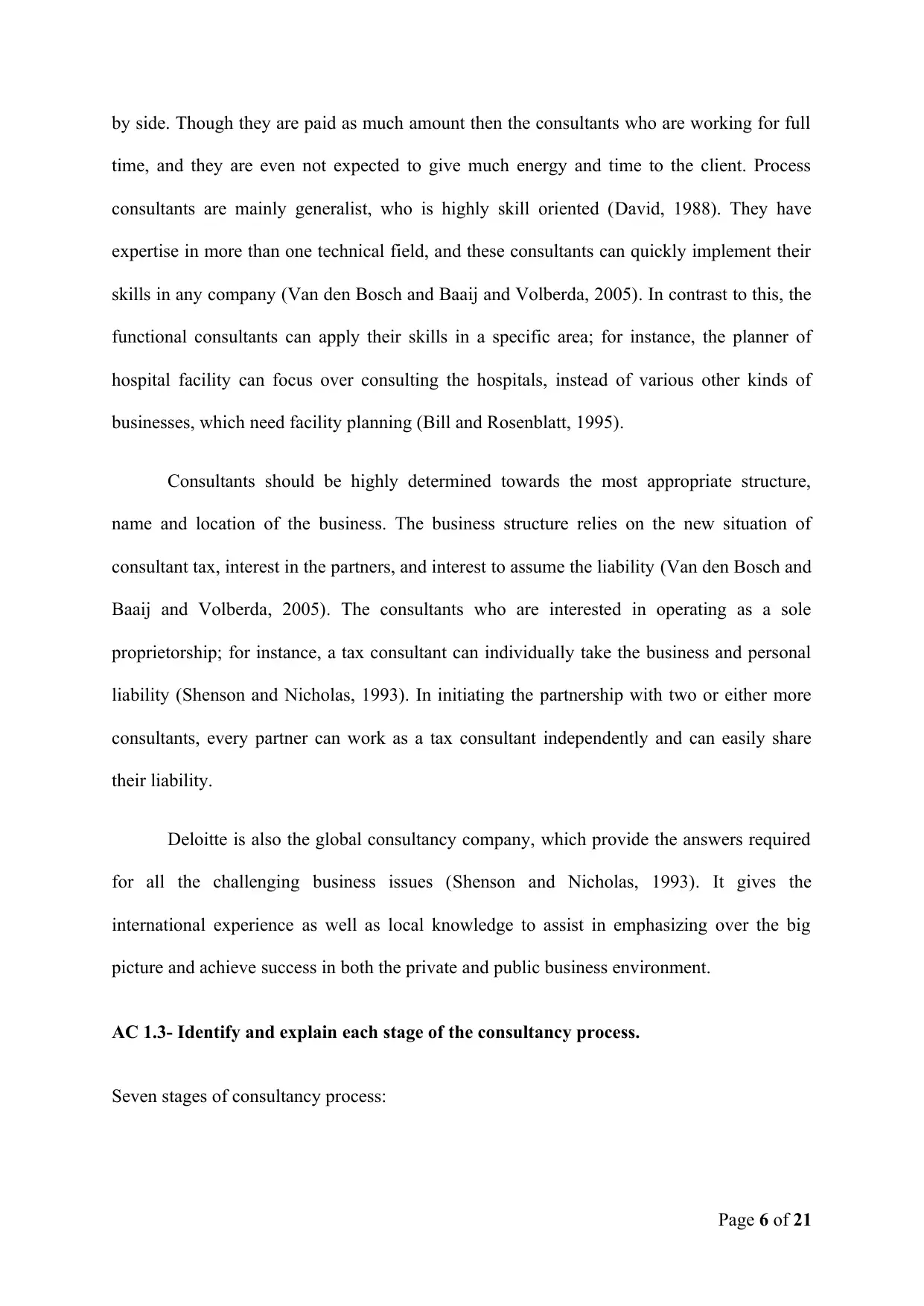
by side. Though they are paid as much amount then the consultants who are working for full
time, and they are even not expected to give much energy and time to the client. Process
consultants are mainly generalist, who is highly skill oriented (David, 1988). They have
expertise in more than one technical field, and these consultants can quickly implement their
skills in any company (Van den Bosch and Baaij and Volberda, 2005). In contrast to this, the
functional consultants can apply their skills in a specific area; for instance, the planner of
hospital facility can focus over consulting the hospitals, instead of various other kinds of
businesses, which need facility planning (Bill and Rosenblatt, 1995).
Consultants should be highly determined towards the most appropriate structure,
name and location of the business. The business structure relies on the new situation of
consultant tax, interest in the partners, and interest to assume the liability (Van den Bosch and
Baaij and Volberda, 2005). The consultants who are interested in operating as a sole
proprietorship; for instance, a tax consultant can individually take the business and personal
liability (Shenson and Nicholas, 1993). In initiating the partnership with two or either more
consultants, every partner can work as a tax consultant independently and can easily share
their liability.
Deloitte is also the global consultancy company, which provide the answers required
for all the challenging business issues (Shenson and Nicholas, 1993). It gives the
international experience as well as local knowledge to assist in emphasizing over the big
picture and achieve success in both the private and public business environment.
AC 1.3- Identify and explain each stage of the consultancy process.
Seven stages of consultancy process:
Page 6 of 21
time, and they are even not expected to give much energy and time to the client. Process
consultants are mainly generalist, who is highly skill oriented (David, 1988). They have
expertise in more than one technical field, and these consultants can quickly implement their
skills in any company (Van den Bosch and Baaij and Volberda, 2005). In contrast to this, the
functional consultants can apply their skills in a specific area; for instance, the planner of
hospital facility can focus over consulting the hospitals, instead of various other kinds of
businesses, which need facility planning (Bill and Rosenblatt, 1995).
Consultants should be highly determined towards the most appropriate structure,
name and location of the business. The business structure relies on the new situation of
consultant tax, interest in the partners, and interest to assume the liability (Van den Bosch and
Baaij and Volberda, 2005). The consultants who are interested in operating as a sole
proprietorship; for instance, a tax consultant can individually take the business and personal
liability (Shenson and Nicholas, 1993). In initiating the partnership with two or either more
consultants, every partner can work as a tax consultant independently and can easily share
their liability.
Deloitte is also the global consultancy company, which provide the answers required
for all the challenging business issues (Shenson and Nicholas, 1993). It gives the
international experience as well as local knowledge to assist in emphasizing over the big
picture and achieve success in both the private and public business environment.
AC 1.3- Identify and explain each stage of the consultancy process.
Seven stages of consultancy process:
Page 6 of 21
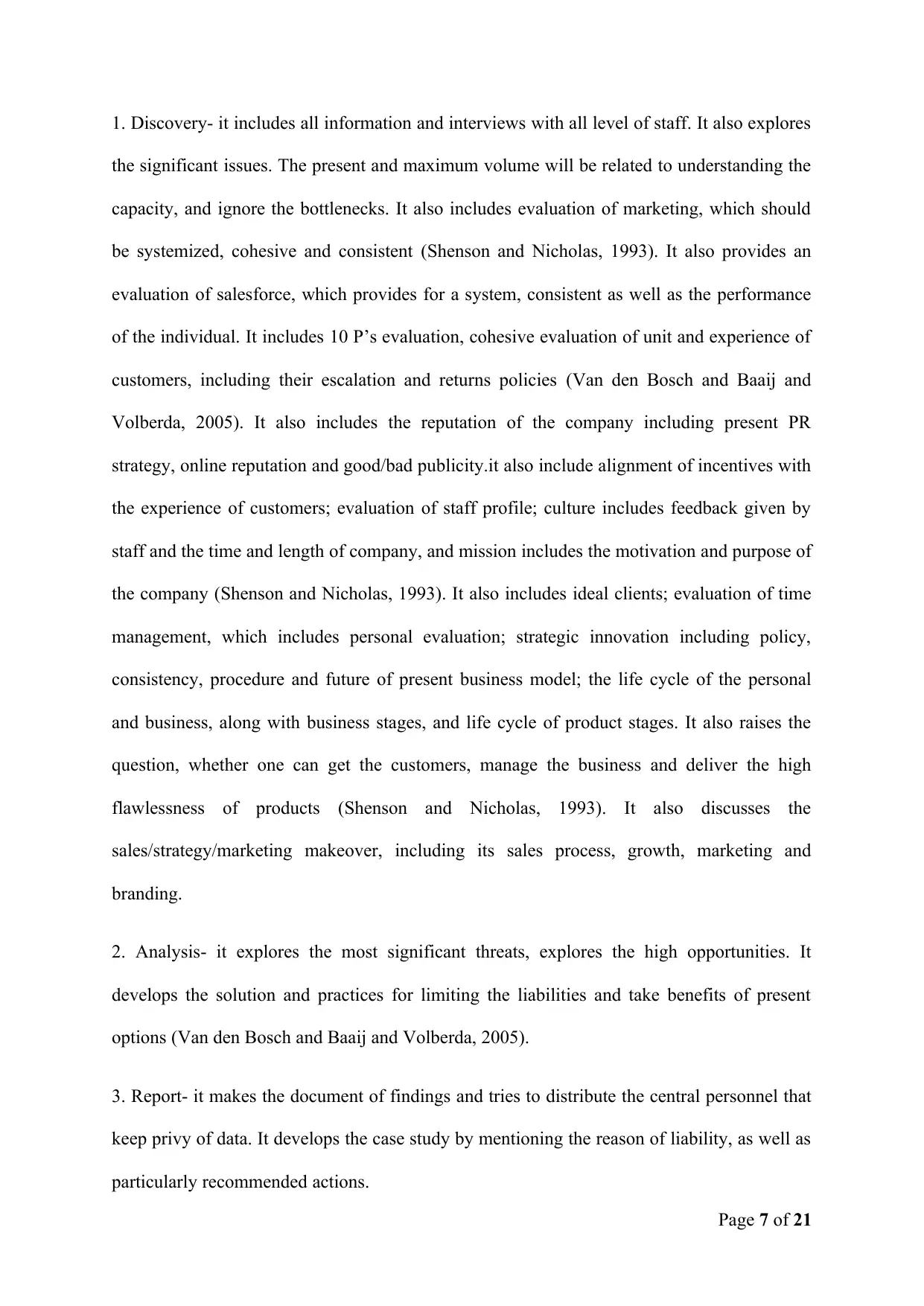
1. Discovery- it includes all information and interviews with all level of staff. It also explores
the significant issues. The present and maximum volume will be related to understanding the
capacity, and ignore the bottlenecks. It also includes evaluation of marketing, which should
be systemized, cohesive and consistent (Shenson and Nicholas, 1993). It also provides an
evaluation of salesforce, which provides for a system, consistent as well as the performance
of the individual. It includes 10 P’s evaluation, cohesive evaluation of unit and experience of
customers, including their escalation and returns policies (Van den Bosch and Baaij and
Volberda, 2005). It also includes the reputation of the company including present PR
strategy, online reputation and good/bad publicity.it also include alignment of incentives with
the experience of customers; evaluation of staff profile; culture includes feedback given by
staff and the time and length of company, and mission includes the motivation and purpose of
the company (Shenson and Nicholas, 1993). It also includes ideal clients; evaluation of time
management, which includes personal evaluation; strategic innovation including policy,
consistency, procedure and future of present business model; the life cycle of the personal
and business, along with business stages, and life cycle of product stages. It also raises the
question, whether one can get the customers, manage the business and deliver the high
flawlessness of products (Shenson and Nicholas, 1993). It also discusses the
sales/strategy/marketing makeover, including its sales process, growth, marketing and
branding.
2. Analysis- it explores the most significant threats, explores the high opportunities. It
develops the solution and practices for limiting the liabilities and take benefits of present
options (Van den Bosch and Baaij and Volberda, 2005).
3. Report- it makes the document of findings and tries to distribute the central personnel that
keep privy of data. It develops the case study by mentioning the reason of liability, as well as
particularly recommended actions.
Page 7 of 21
the significant issues. The present and maximum volume will be related to understanding the
capacity, and ignore the bottlenecks. It also includes evaluation of marketing, which should
be systemized, cohesive and consistent (Shenson and Nicholas, 1993). It also provides an
evaluation of salesforce, which provides for a system, consistent as well as the performance
of the individual. It includes 10 P’s evaluation, cohesive evaluation of unit and experience of
customers, including their escalation and returns policies (Van den Bosch and Baaij and
Volberda, 2005). It also includes the reputation of the company including present PR
strategy, online reputation and good/bad publicity.it also include alignment of incentives with
the experience of customers; evaluation of staff profile; culture includes feedback given by
staff and the time and length of company, and mission includes the motivation and purpose of
the company (Shenson and Nicholas, 1993). It also includes ideal clients; evaluation of time
management, which includes personal evaluation; strategic innovation including policy,
consistency, procedure and future of present business model; the life cycle of the personal
and business, along with business stages, and life cycle of product stages. It also raises the
question, whether one can get the customers, manage the business and deliver the high
flawlessness of products (Shenson and Nicholas, 1993). It also discusses the
sales/strategy/marketing makeover, including its sales process, growth, marketing and
branding.
2. Analysis- it explores the most significant threats, explores the high opportunities. It
develops the solution and practices for limiting the liabilities and take benefits of present
options (Van den Bosch and Baaij and Volberda, 2005).
3. Report- it makes the document of findings and tries to distribute the central personnel that
keep privy of data. It develops the case study by mentioning the reason of liability, as well as
particularly recommended actions.
Page 7 of 21
Paraphrase This Document
Need a fresh take? Get an instant paraphrase of this document with our AI Paraphraser
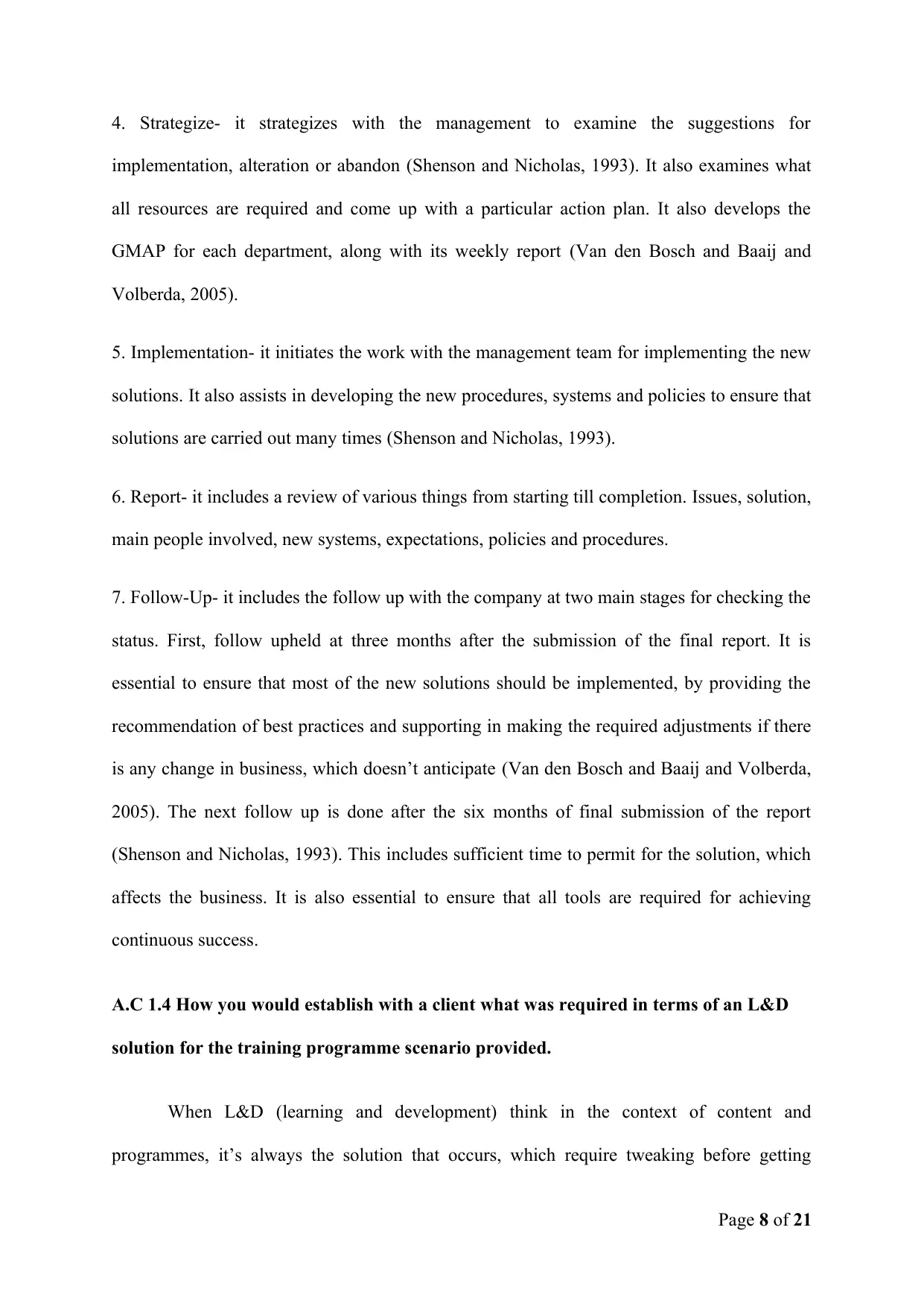
4. Strategize- it strategizes with the management to examine the suggestions for
implementation, alteration or abandon (Shenson and Nicholas, 1993). It also examines what
all resources are required and come up with a particular action plan. It also develops the
GMAP for each department, along with its weekly report (Van den Bosch and Baaij and
Volberda, 2005).
5. Implementation- it initiates the work with the management team for implementing the new
solutions. It also assists in developing the new procedures, systems and policies to ensure that
solutions are carried out many times (Shenson and Nicholas, 1993).
6. Report- it includes a review of various things from starting till completion. Issues, solution,
main people involved, new systems, expectations, policies and procedures.
7. Follow-Up- it includes the follow up with the company at two main stages for checking the
status. First, follow upheld at three months after the submission of the final report. It is
essential to ensure that most of the new solutions should be implemented, by providing the
recommendation of best practices and supporting in making the required adjustments if there
is any change in business, which doesn’t anticipate (Van den Bosch and Baaij and Volberda,
2005). The next follow up is done after the six months of final submission of the report
(Shenson and Nicholas, 1993). This includes sufficient time to permit for the solution, which
affects the business. It is also essential to ensure that all tools are required for achieving
continuous success.
A.C 1.4 How you would establish with a client what was required in terms of an L&D
solution for the training programme scenario provided.
When L&D (learning and development) think in the context of content and
programmes, it’s always the solution that occurs, which require tweaking before getting
Page 8 of 21
implementation, alteration or abandon (Shenson and Nicholas, 1993). It also examines what
all resources are required and come up with a particular action plan. It also develops the
GMAP for each department, along with its weekly report (Van den Bosch and Baaij and
Volberda, 2005).
5. Implementation- it initiates the work with the management team for implementing the new
solutions. It also assists in developing the new procedures, systems and policies to ensure that
solutions are carried out many times (Shenson and Nicholas, 1993).
6. Report- it includes a review of various things from starting till completion. Issues, solution,
main people involved, new systems, expectations, policies and procedures.
7. Follow-Up- it includes the follow up with the company at two main stages for checking the
status. First, follow upheld at three months after the submission of the final report. It is
essential to ensure that most of the new solutions should be implemented, by providing the
recommendation of best practices and supporting in making the required adjustments if there
is any change in business, which doesn’t anticipate (Van den Bosch and Baaij and Volberda,
2005). The next follow up is done after the six months of final submission of the report
(Shenson and Nicholas, 1993). This includes sufficient time to permit for the solution, which
affects the business. It is also essential to ensure that all tools are required for achieving
continuous success.
A.C 1.4 How you would establish with a client what was required in terms of an L&D
solution for the training programme scenario provided.
When L&D (learning and development) think in the context of content and
programmes, it’s always the solution that occurs, which require tweaking before getting
Page 8 of 21
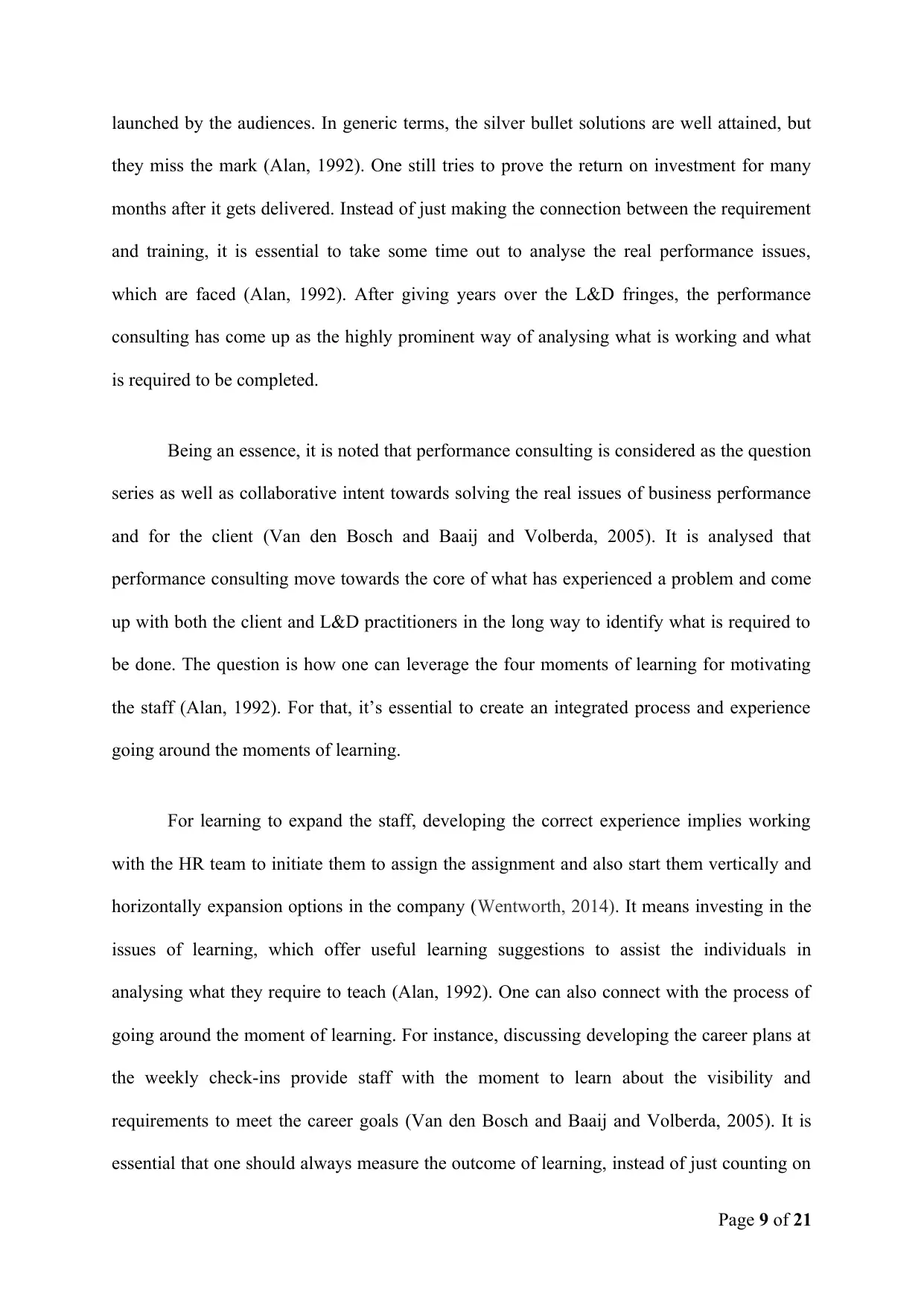
launched by the audiences. In generic terms, the silver bullet solutions are well attained, but
they miss the mark (Alan, 1992). One still tries to prove the return on investment for many
months after it gets delivered. Instead of just making the connection between the requirement
and training, it is essential to take some time out to analyse the real performance issues,
which are faced (Alan, 1992). After giving years over the L&D fringes, the performance
consulting has come up as the highly prominent way of analysing what is working and what
is required to be completed.
Being an essence, it is noted that performance consulting is considered as the question
series as well as collaborative intent towards solving the real issues of business performance
and for the client (Van den Bosch and Baaij and Volberda, 2005). It is analysed that
performance consulting move towards the core of what has experienced a problem and come
up with both the client and L&D practitioners in the long way to identify what is required to
be done. The question is how one can leverage the four moments of learning for motivating
the staff (Alan, 1992). For that, it’s essential to create an integrated process and experience
going around the moments of learning.
For learning to expand the staff, developing the correct experience implies working
with the HR team to initiate them to assign the assignment and also start them vertically and
horizontally expansion options in the company (Wentworth, 2014). It means investing in the
issues of learning, which offer useful learning suggestions to assist the individuals in
analysing what they require to teach (Alan, 1992). One can also connect with the process of
going around the moment of learning. For instance, discussing developing the career plans at
the weekly check-ins provide staff with the moment to learn about the visibility and
requirements to meet the career goals (Van den Bosch and Baaij and Volberda, 2005). It is
essential that one should always measure the outcome of learning, instead of just counting on
Page 9 of 21
they miss the mark (Alan, 1992). One still tries to prove the return on investment for many
months after it gets delivered. Instead of just making the connection between the requirement
and training, it is essential to take some time out to analyse the real performance issues,
which are faced (Alan, 1992). After giving years over the L&D fringes, the performance
consulting has come up as the highly prominent way of analysing what is working and what
is required to be completed.
Being an essence, it is noted that performance consulting is considered as the question
series as well as collaborative intent towards solving the real issues of business performance
and for the client (Van den Bosch and Baaij and Volberda, 2005). It is analysed that
performance consulting move towards the core of what has experienced a problem and come
up with both the client and L&D practitioners in the long way to identify what is required to
be done. The question is how one can leverage the four moments of learning for motivating
the staff (Alan, 1992). For that, it’s essential to create an integrated process and experience
going around the moments of learning.
For learning to expand the staff, developing the correct experience implies working
with the HR team to initiate them to assign the assignment and also start them vertically and
horizontally expansion options in the company (Wentworth, 2014). It means investing in the
issues of learning, which offer useful learning suggestions to assist the individuals in
analysing what they require to teach (Alan, 1992). One can also connect with the process of
going around the moment of learning. For instance, discussing developing the career plans at
the weekly check-ins provide staff with the moment to learn about the visibility and
requirements to meet the career goals (Van den Bosch and Baaij and Volberda, 2005). It is
essential that one should always measure the outcome of learning, instead of just counting on
Page 9 of 21
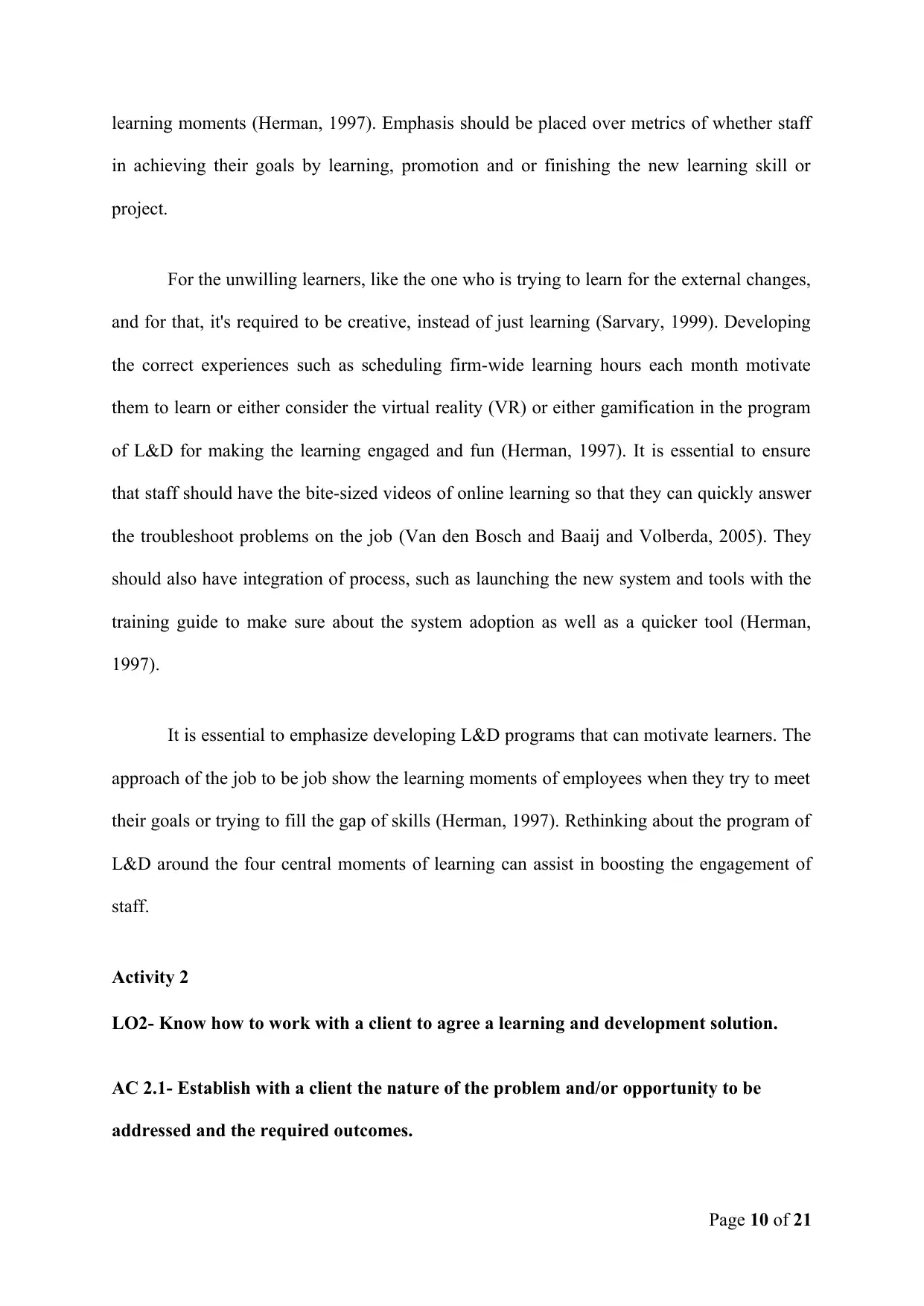
learning moments (Herman, 1997). Emphasis should be placed over metrics of whether staff
in achieving their goals by learning, promotion and or finishing the new learning skill or
project.
For the unwilling learners, like the one who is trying to learn for the external changes,
and for that, it's required to be creative, instead of just learning (Sarvary, 1999). Developing
the correct experiences such as scheduling firm-wide learning hours each month motivate
them to learn or either consider the virtual reality (VR) or either gamification in the program
of L&D for making the learning engaged and fun (Herman, 1997). It is essential to ensure
that staff should have the bite-sized videos of online learning so that they can quickly answer
the troubleshoot problems on the job (Van den Bosch and Baaij and Volberda, 2005). They
should also have integration of process, such as launching the new system and tools with the
training guide to make sure about the system adoption as well as a quicker tool (Herman,
1997).
It is essential to emphasize developing L&D programs that can motivate learners. The
approach of the job to be job show the learning moments of employees when they try to meet
their goals or trying to fill the gap of skills (Herman, 1997). Rethinking about the program of
L&D around the four central moments of learning can assist in boosting the engagement of
staff.
Activity 2
LO2- Know how to work with a client to agree a learning and development solution.
AC 2.1- Establish with a client the nature of the problem and/or opportunity to be
addressed and the required outcomes.
Page 10 of 21
in achieving their goals by learning, promotion and or finishing the new learning skill or
project.
For the unwilling learners, like the one who is trying to learn for the external changes,
and for that, it's required to be creative, instead of just learning (Sarvary, 1999). Developing
the correct experiences such as scheduling firm-wide learning hours each month motivate
them to learn or either consider the virtual reality (VR) or either gamification in the program
of L&D for making the learning engaged and fun (Herman, 1997). It is essential to ensure
that staff should have the bite-sized videos of online learning so that they can quickly answer
the troubleshoot problems on the job (Van den Bosch and Baaij and Volberda, 2005). They
should also have integration of process, such as launching the new system and tools with the
training guide to make sure about the system adoption as well as a quicker tool (Herman,
1997).
It is essential to emphasize developing L&D programs that can motivate learners. The
approach of the job to be job show the learning moments of employees when they try to meet
their goals or trying to fill the gap of skills (Herman, 1997). Rethinking about the program of
L&D around the four central moments of learning can assist in boosting the engagement of
staff.
Activity 2
LO2- Know how to work with a client to agree a learning and development solution.
AC 2.1- Establish with a client the nature of the problem and/or opportunity to be
addressed and the required outcomes.
Page 10 of 21
Secure Best Marks with AI Grader
Need help grading? Try our AI Grader for instant feedback on your assignments.
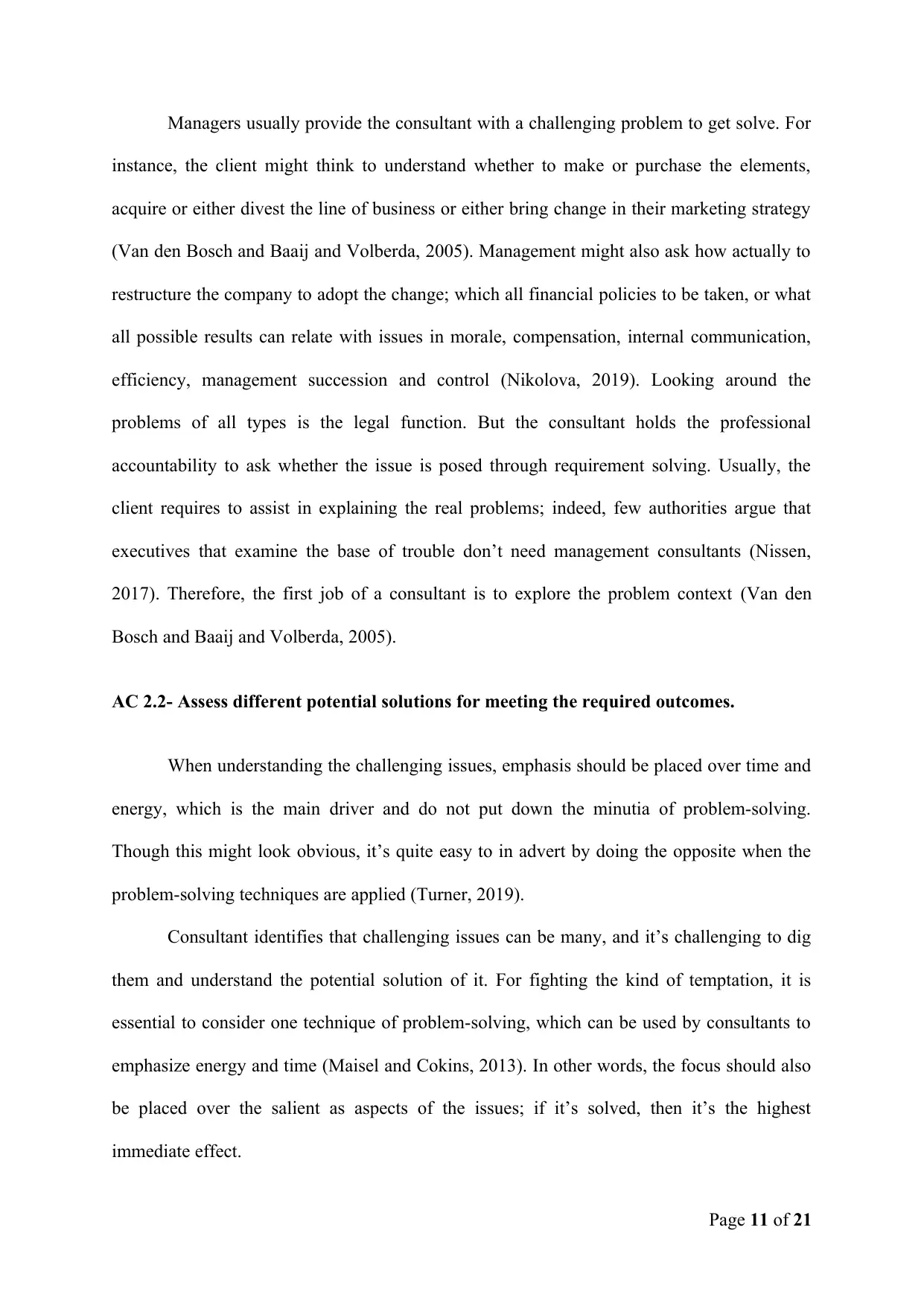
Managers usually provide the consultant with a challenging problem to get solve. For
instance, the client might think to understand whether to make or purchase the elements,
acquire or either divest the line of business or either bring change in their marketing strategy
(Van den Bosch and Baaij and Volberda, 2005). Management might also ask how actually to
restructure the company to adopt the change; which all financial policies to be taken, or what
all possible results can relate with issues in morale, compensation, internal communication,
efficiency, management succession and control (Nikolova, 2019). Looking around the
problems of all types is the legal function. But the consultant holds the professional
accountability to ask whether the issue is posed through requirement solving. Usually, the
client requires to assist in explaining the real problems; indeed, few authorities argue that
executives that examine the base of trouble don’t need management consultants (Nissen,
2017). Therefore, the first job of a consultant is to explore the problem context (Van den
Bosch and Baaij and Volberda, 2005).
AC 2.2- Assess different potential solutions for meeting the required outcomes.
When understanding the challenging issues, emphasis should be placed over time and
energy, which is the main driver and do not put down the minutia of problem-solving.
Though this might look obvious, it’s quite easy to in advert by doing the opposite when the
problem-solving techniques are applied (Turner, 2019).
Consultant identifies that challenging issues can be many, and it’s challenging to dig
them and understand the potential solution of it. For fighting the kind of temptation, it is
essential to consider one technique of problem-solving, which can be used by consultants to
emphasize energy and time (Maisel and Cokins, 2013). In other words, the focus should also
be placed over the salient as aspects of the issues; if it’s solved, then it’s the highest
immediate effect.
Page 11 of 21
instance, the client might think to understand whether to make or purchase the elements,
acquire or either divest the line of business or either bring change in their marketing strategy
(Van den Bosch and Baaij and Volberda, 2005). Management might also ask how actually to
restructure the company to adopt the change; which all financial policies to be taken, or what
all possible results can relate with issues in morale, compensation, internal communication,
efficiency, management succession and control (Nikolova, 2019). Looking around the
problems of all types is the legal function. But the consultant holds the professional
accountability to ask whether the issue is posed through requirement solving. Usually, the
client requires to assist in explaining the real problems; indeed, few authorities argue that
executives that examine the base of trouble don’t need management consultants (Nissen,
2017). Therefore, the first job of a consultant is to explore the problem context (Van den
Bosch and Baaij and Volberda, 2005).
AC 2.2- Assess different potential solutions for meeting the required outcomes.
When understanding the challenging issues, emphasis should be placed over time and
energy, which is the main driver and do not put down the minutia of problem-solving.
Though this might look obvious, it’s quite easy to in advert by doing the opposite when the
problem-solving techniques are applied (Turner, 2019).
Consultant identifies that challenging issues can be many, and it’s challenging to dig
them and understand the potential solution of it. For fighting the kind of temptation, it is
essential to consider one technique of problem-solving, which can be used by consultants to
emphasize energy and time (Maisel and Cokins, 2013). In other words, the focus should also
be placed over the salient as aspects of the issues; if it’s solved, then it’s the highest
immediate effect.
Page 11 of 21
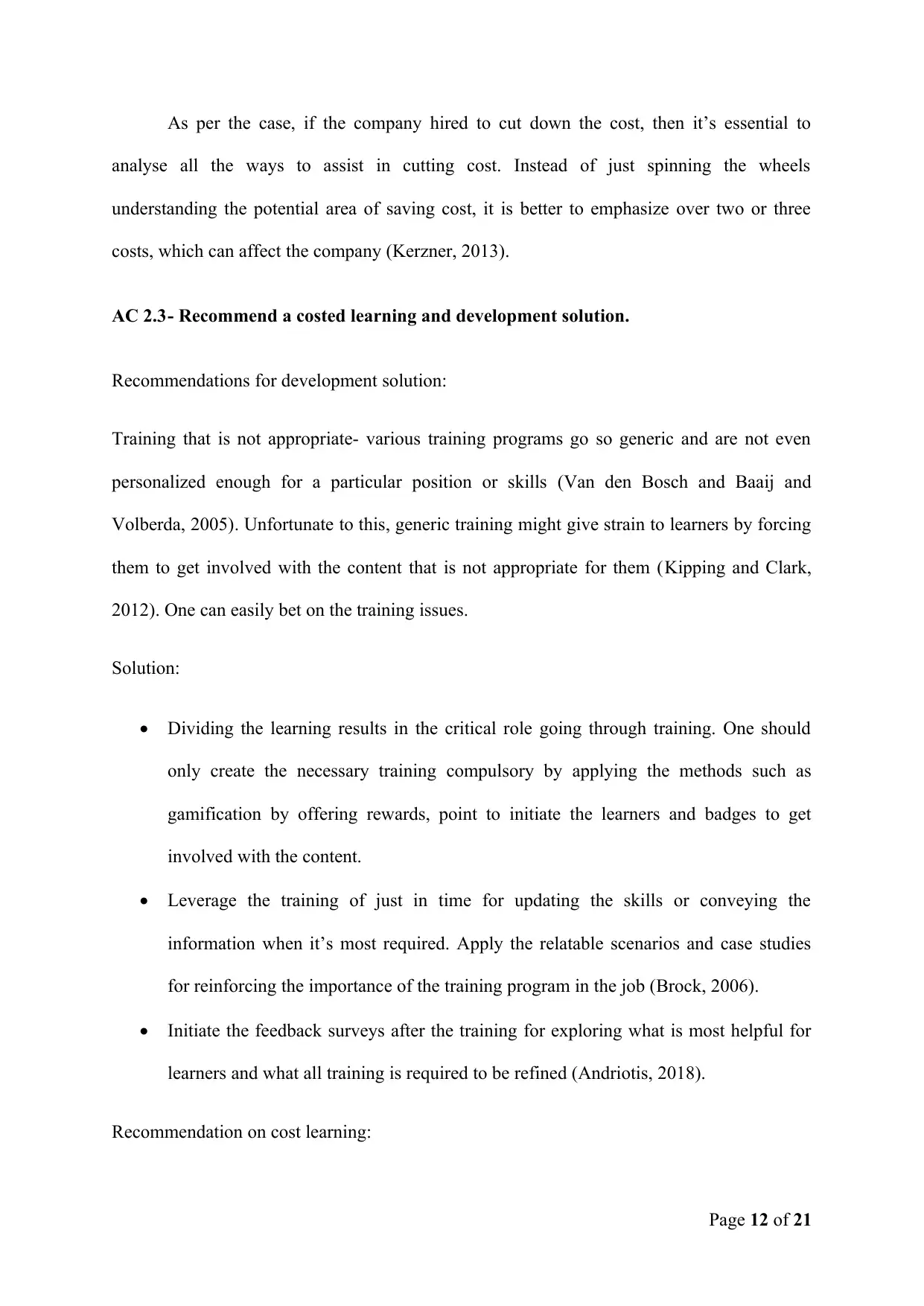
As per the case, if the company hired to cut down the cost, then it’s essential to
analyse all the ways to assist in cutting cost. Instead of just spinning the wheels
understanding the potential area of saving cost, it is better to emphasize over two or three
costs, which can affect the company (Kerzner, 2013).
AC 2.3- Recommend a costed learning and development solution.
Recommendations for development solution:
Training that is not appropriate- various training programs go so generic and are not even
personalized enough for a particular position or skills (Van den Bosch and Baaij and
Volberda, 2005). Unfortunate to this, generic training might give strain to learners by forcing
them to get involved with the content that is not appropriate for them (Kipping and Clark,
2012). One can easily bet on the training issues.
Solution:
Dividing the learning results in the critical role going through training. One should
only create the necessary training compulsory by applying the methods such as
gamification by offering rewards, point to initiate the learners and badges to get
involved with the content.
Leverage the training of just in time for updating the skills or conveying the
information when it’s most required. Apply the relatable scenarios and case studies
for reinforcing the importance of the training program in the job (Brock, 2006).
Initiate the feedback surveys after the training for exploring what is most helpful for
learners and what all training is required to be refined (Andriotis, 2018).
Recommendation on cost learning:
Page 12 of 21
analyse all the ways to assist in cutting cost. Instead of just spinning the wheels
understanding the potential area of saving cost, it is better to emphasize over two or three
costs, which can affect the company (Kerzner, 2013).
AC 2.3- Recommend a costed learning and development solution.
Recommendations for development solution:
Training that is not appropriate- various training programs go so generic and are not even
personalized enough for a particular position or skills (Van den Bosch and Baaij and
Volberda, 2005). Unfortunate to this, generic training might give strain to learners by forcing
them to get involved with the content that is not appropriate for them (Kipping and Clark,
2012). One can easily bet on the training issues.
Solution:
Dividing the learning results in the critical role going through training. One should
only create the necessary training compulsory by applying the methods such as
gamification by offering rewards, point to initiate the learners and badges to get
involved with the content.
Leverage the training of just in time for updating the skills or conveying the
information when it’s most required. Apply the relatable scenarios and case studies
for reinforcing the importance of the training program in the job (Brock, 2006).
Initiate the feedback surveys after the training for exploring what is most helpful for
learners and what all training is required to be refined (Andriotis, 2018).
Recommendation on cost learning:
Page 12 of 21
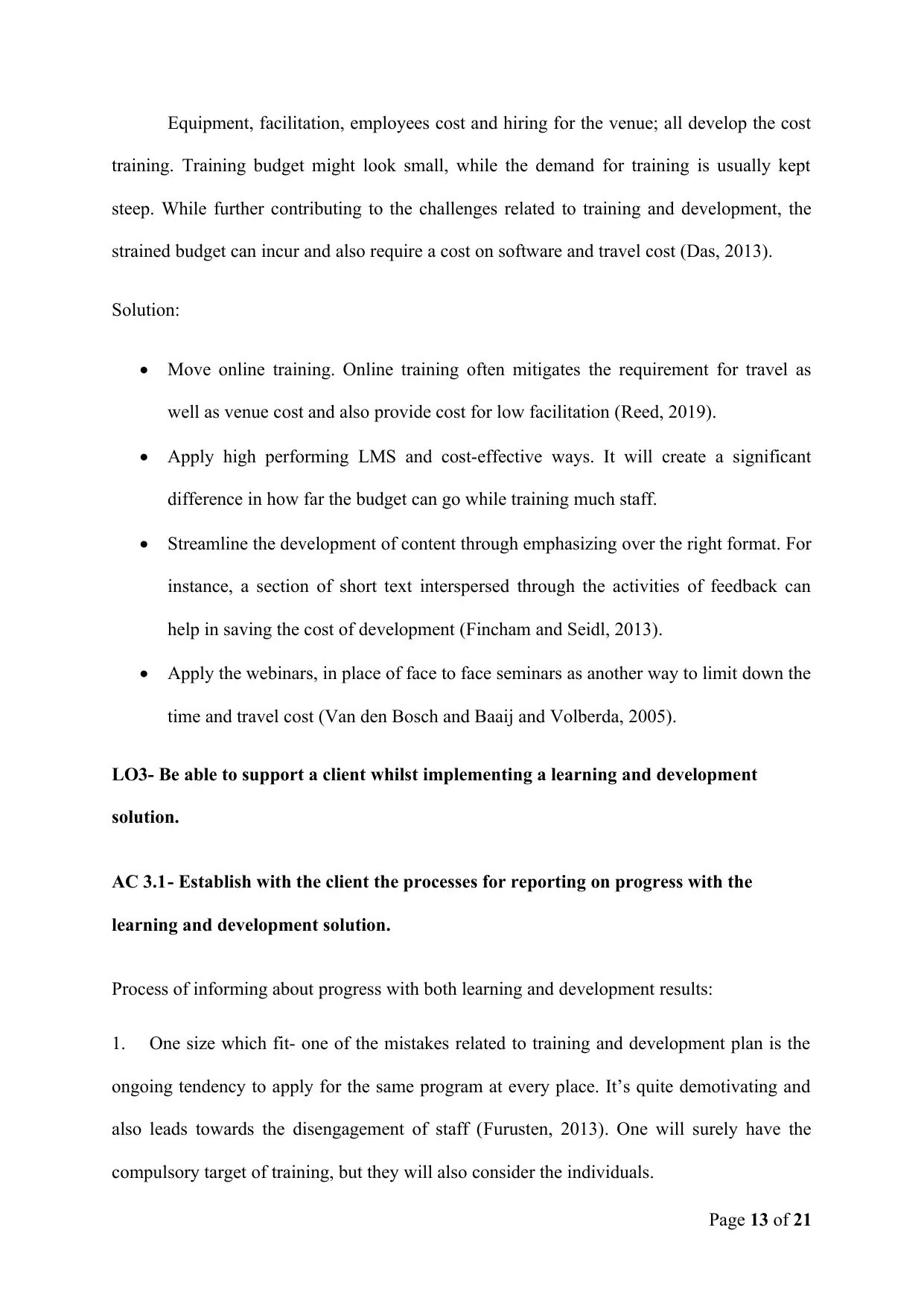
Equipment, facilitation, employees cost and hiring for the venue; all develop the cost
training. Training budget might look small, while the demand for training is usually kept
steep. While further contributing to the challenges related to training and development, the
strained budget can incur and also require a cost on software and travel cost (Das, 2013).
Solution:
Move online training. Online training often mitigates the requirement for travel as
well as venue cost and also provide cost for low facilitation (Reed, 2019).
Apply high performing LMS and cost-effective ways. It will create a significant
difference in how far the budget can go while training much staff.
Streamline the development of content through emphasizing over the right format. For
instance, a section of short text interspersed through the activities of feedback can
help in saving the cost of development (Fincham and Seidl, 2013).
Apply the webinars, in place of face to face seminars as another way to limit down the
time and travel cost (Van den Bosch and Baaij and Volberda, 2005).
LO3- Be able to support a client whilst implementing a learning and development
solution.
AC 3.1- Establish with the client the processes for reporting on progress with the
learning and development solution.
Process of informing about progress with both learning and development results:
1. One size which fit- one of the mistakes related to training and development plan is the
ongoing tendency to apply for the same program at every place. It’s quite demotivating and
also leads towards the disengagement of staff (Furusten, 2013). One will surely have the
compulsory target of training, but they will also consider the individuals.
Page 13 of 21
training. Training budget might look small, while the demand for training is usually kept
steep. While further contributing to the challenges related to training and development, the
strained budget can incur and also require a cost on software and travel cost (Das, 2013).
Solution:
Move online training. Online training often mitigates the requirement for travel as
well as venue cost and also provide cost for low facilitation (Reed, 2019).
Apply high performing LMS and cost-effective ways. It will create a significant
difference in how far the budget can go while training much staff.
Streamline the development of content through emphasizing over the right format. For
instance, a section of short text interspersed through the activities of feedback can
help in saving the cost of development (Fincham and Seidl, 2013).
Apply the webinars, in place of face to face seminars as another way to limit down the
time and travel cost (Van den Bosch and Baaij and Volberda, 2005).
LO3- Be able to support a client whilst implementing a learning and development
solution.
AC 3.1- Establish with the client the processes for reporting on progress with the
learning and development solution.
Process of informing about progress with both learning and development results:
1. One size which fit- one of the mistakes related to training and development plan is the
ongoing tendency to apply for the same program at every place. It’s quite demotivating and
also leads towards the disengagement of staff (Furusten, 2013). One will surely have the
compulsory target of training, but they will also consider the individuals.
Page 13 of 21
Paraphrase This Document
Need a fresh take? Get an instant paraphrase of this document with our AI Paraphraser

2. Explore the staff requirements- it’s essential that one should target on in which area staff
require training. Someone that works in the sales section will need various tools as compared
to engineering (Maister, 1993). After all this, the question is whether the employees training
is more effective when they are focused on?
3. Flexibility and limitations- it is significant to offer flexibility in the training and
development approach. One requires to refer when staff can go for training. The question
here is that of one has dispersed international team, then it’s most unlikely that one can make
come close, in that such case talent development platform is proved to be highly effective
(Furusten, 2013). Nevertheless, one will create the limit on which training should be targeted
and what time is agreed by staff to complete the project (Momani, 2013).
4. The training development program is massive or either vague- one problem that appraisal
often face is related to training goals are enormous and often unachievable. Same things
move with the vague objective of learning (Hagenmeyer, 2010). Appraisers often require
training for developing the available list, the small target for every staff, for which one can
realistically finish the agreed limit of time.
5. Progress tracking- staff training report of tracking is an essential characteristic in the
development program of staff. They should start with the moment when the T&D
individually approve and follow the progress of the team and ends with analysing that they
have finished the feedback. And it moves by mentioning that process is a cycle that goes
throughout the staff career in an organization (Jensen, Poulfelt and Kraus, 2010).
AC 3.2- Report on the outcomes of the learning and development solution.
The rise in the budget, as well as administrative support, are giving the path to the
talent developers to play a strategic role within the business (Semadini, 2006). In the year
Page 14 of 21
require training. Someone that works in the sales section will need various tools as compared
to engineering (Maister, 1993). After all this, the question is whether the employees training
is more effective when they are focused on?
3. Flexibility and limitations- it is significant to offer flexibility in the training and
development approach. One requires to refer when staff can go for training. The question
here is that of one has dispersed international team, then it’s most unlikely that one can make
come close, in that such case talent development platform is proved to be highly effective
(Furusten, 2013). Nevertheless, one will create the limit on which training should be targeted
and what time is agreed by staff to complete the project (Momani, 2013).
4. The training development program is massive or either vague- one problem that appraisal
often face is related to training goals are enormous and often unachievable. Same things
move with the vague objective of learning (Hagenmeyer, 2010). Appraisers often require
training for developing the available list, the small target for every staff, for which one can
realistically finish the agreed limit of time.
5. Progress tracking- staff training report of tracking is an essential characteristic in the
development program of staff. They should start with the moment when the T&D
individually approve and follow the progress of the team and ends with analysing that they
have finished the feedback. And it moves by mentioning that process is a cycle that goes
throughout the staff career in an organization (Jensen, Poulfelt and Kraus, 2010).
AC 3.2- Report on the outcomes of the learning and development solution.
The rise in the budget, as well as administrative support, are giving the path to the
talent developers to play a strategic role within the business (Semadini, 2006). In the year
Page 14 of 21
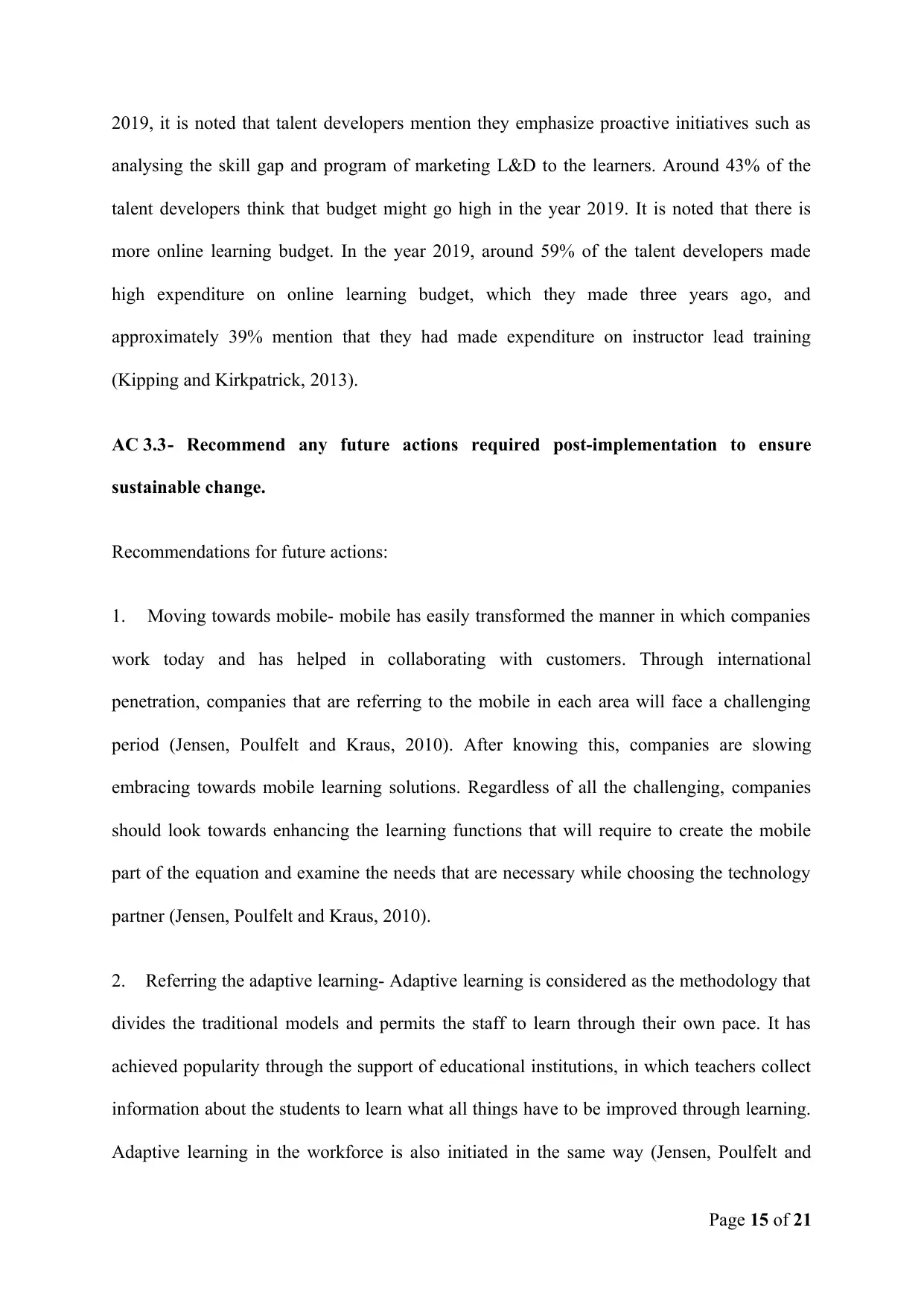
2019, it is noted that talent developers mention they emphasize proactive initiatives such as
analysing the skill gap and program of marketing L&D to the learners. Around 43% of the
talent developers think that budget might go high in the year 2019. It is noted that there is
more online learning budget. In the year 2019, around 59% of the talent developers made
high expenditure on online learning budget, which they made three years ago, and
approximately 39% mention that they had made expenditure on instructor lead training
(Kipping and Kirkpatrick, 2013).
AC 3.3- Recommend any future actions required post-implementation to ensure
sustainable change.
Recommendations for future actions:
1. Moving towards mobile- mobile has easily transformed the manner in which companies
work today and has helped in collaborating with customers. Through international
penetration, companies that are referring to the mobile in each area will face a challenging
period (Jensen, Poulfelt and Kraus, 2010). After knowing this, companies are slowing
embracing towards mobile learning solutions. Regardless of all the challenging, companies
should look towards enhancing the learning functions that will require to create the mobile
part of the equation and examine the needs that are necessary while choosing the technology
partner (Jensen, Poulfelt and Kraus, 2010).
2. Referring the adaptive learning- Adaptive learning is considered as the methodology that
divides the traditional models and permits the staff to learn through their own pace. It has
achieved popularity through the support of educational institutions, in which teachers collect
information about the students to learn what all things have to be improved through learning.
Adaptive learning in the workforce is also initiated in the same way (Jensen, Poulfelt and
Page 15 of 21
analysing the skill gap and program of marketing L&D to the learners. Around 43% of the
talent developers think that budget might go high in the year 2019. It is noted that there is
more online learning budget. In the year 2019, around 59% of the talent developers made
high expenditure on online learning budget, which they made three years ago, and
approximately 39% mention that they had made expenditure on instructor lead training
(Kipping and Kirkpatrick, 2013).
AC 3.3- Recommend any future actions required post-implementation to ensure
sustainable change.
Recommendations for future actions:
1. Moving towards mobile- mobile has easily transformed the manner in which companies
work today and has helped in collaborating with customers. Through international
penetration, companies that are referring to the mobile in each area will face a challenging
period (Jensen, Poulfelt and Kraus, 2010). After knowing this, companies are slowing
embracing towards mobile learning solutions. Regardless of all the challenging, companies
should look towards enhancing the learning functions that will require to create the mobile
part of the equation and examine the needs that are necessary while choosing the technology
partner (Jensen, Poulfelt and Kraus, 2010).
2. Referring the adaptive learning- Adaptive learning is considered as the methodology that
divides the traditional models and permits the staff to learn through their own pace. It has
achieved popularity through the support of educational institutions, in which teachers collect
information about the students to learn what all things have to be improved through learning.
Adaptive learning in the workforce is also initiated in the same way (Jensen, Poulfelt and
Page 15 of 21
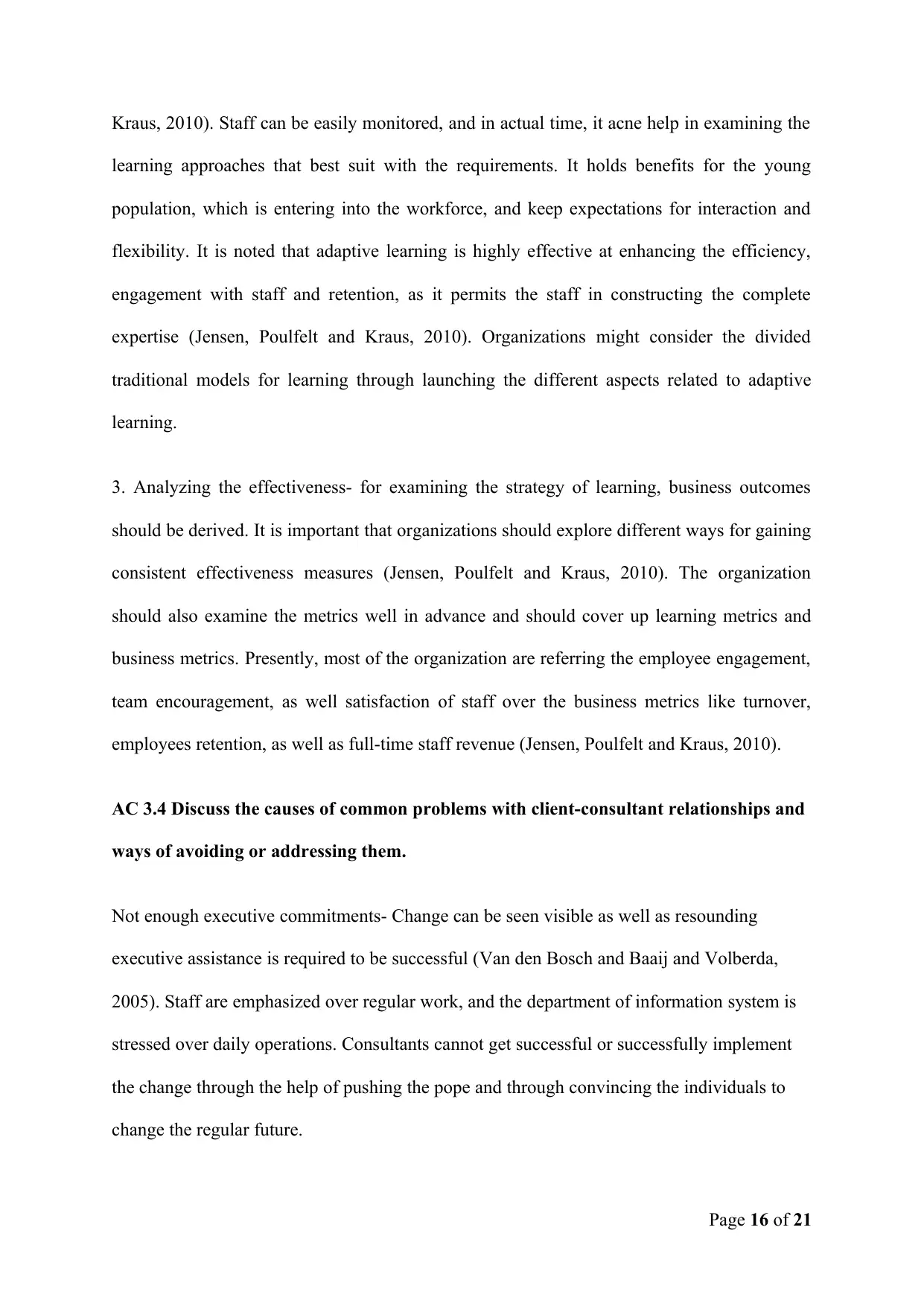
Kraus, 2010). Staff can be easily monitored, and in actual time, it acne help in examining the
learning approaches that best suit with the requirements. It holds benefits for the young
population, which is entering into the workforce, and keep expectations for interaction and
flexibility. It is noted that adaptive learning is highly effective at enhancing the efficiency,
engagement with staff and retention, as it permits the staff in constructing the complete
expertise (Jensen, Poulfelt and Kraus, 2010). Organizations might consider the divided
traditional models for learning through launching the different aspects related to adaptive
learning.
3. Analyzing the effectiveness- for examining the strategy of learning, business outcomes
should be derived. It is important that organizations should explore different ways for gaining
consistent effectiveness measures (Jensen, Poulfelt and Kraus, 2010). The organization
should also examine the metrics well in advance and should cover up learning metrics and
business metrics. Presently, most of the organization are referring the employee engagement,
team encouragement, as well satisfaction of staff over the business metrics like turnover,
employees retention, as well as full-time staff revenue (Jensen, Poulfelt and Kraus, 2010).
AC 3.4 Discuss the causes of common problems with client-consultant relationships and
ways of avoiding or addressing them.
Not enough executive commitments- Change can be seen visible as well as resounding
executive assistance is required to be successful (Van den Bosch and Baaij and Volberda,
2005). Staff are emphasized over regular work, and the department of information system is
stressed over daily operations. Consultants cannot get successful or successfully implement
the change through the help of pushing the pope and through convincing the individuals to
change the regular future.
Page 16 of 21
learning approaches that best suit with the requirements. It holds benefits for the young
population, which is entering into the workforce, and keep expectations for interaction and
flexibility. It is noted that adaptive learning is highly effective at enhancing the efficiency,
engagement with staff and retention, as it permits the staff in constructing the complete
expertise (Jensen, Poulfelt and Kraus, 2010). Organizations might consider the divided
traditional models for learning through launching the different aspects related to adaptive
learning.
3. Analyzing the effectiveness- for examining the strategy of learning, business outcomes
should be derived. It is important that organizations should explore different ways for gaining
consistent effectiveness measures (Jensen, Poulfelt and Kraus, 2010). The organization
should also examine the metrics well in advance and should cover up learning metrics and
business metrics. Presently, most of the organization are referring the employee engagement,
team encouragement, as well satisfaction of staff over the business metrics like turnover,
employees retention, as well as full-time staff revenue (Jensen, Poulfelt and Kraus, 2010).
AC 3.4 Discuss the causes of common problems with client-consultant relationships and
ways of avoiding or addressing them.
Not enough executive commitments- Change can be seen visible as well as resounding
executive assistance is required to be successful (Van den Bosch and Baaij and Volberda,
2005). Staff are emphasized over regular work, and the department of information system is
stressed over daily operations. Consultants cannot get successful or successfully implement
the change through the help of pushing the pope and through convincing the individuals to
change the regular future.
Page 16 of 21
Secure Best Marks with AI Grader
Need help grading? Try our AI Grader for instant feedback on your assignments.
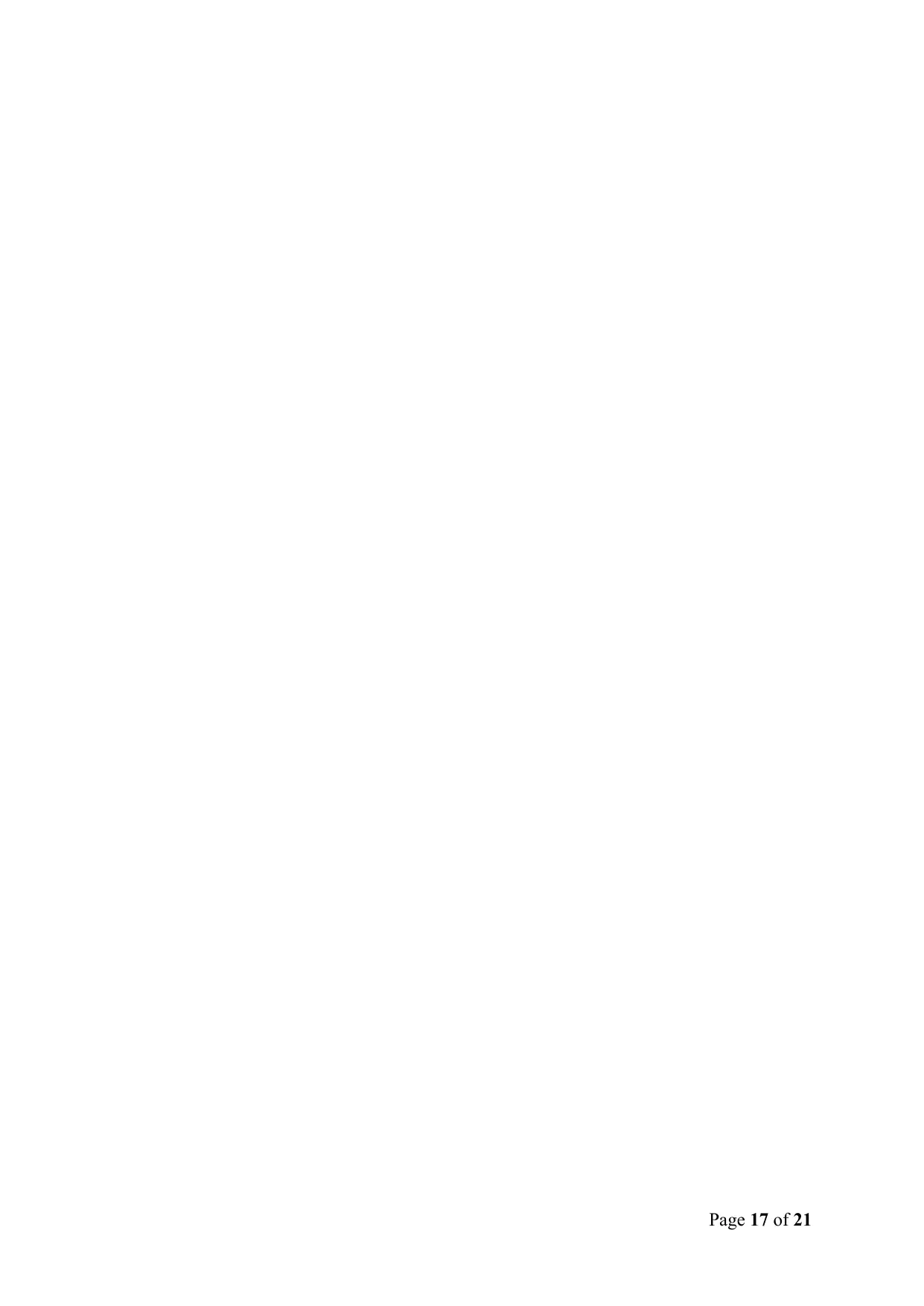
Page 17 of 21
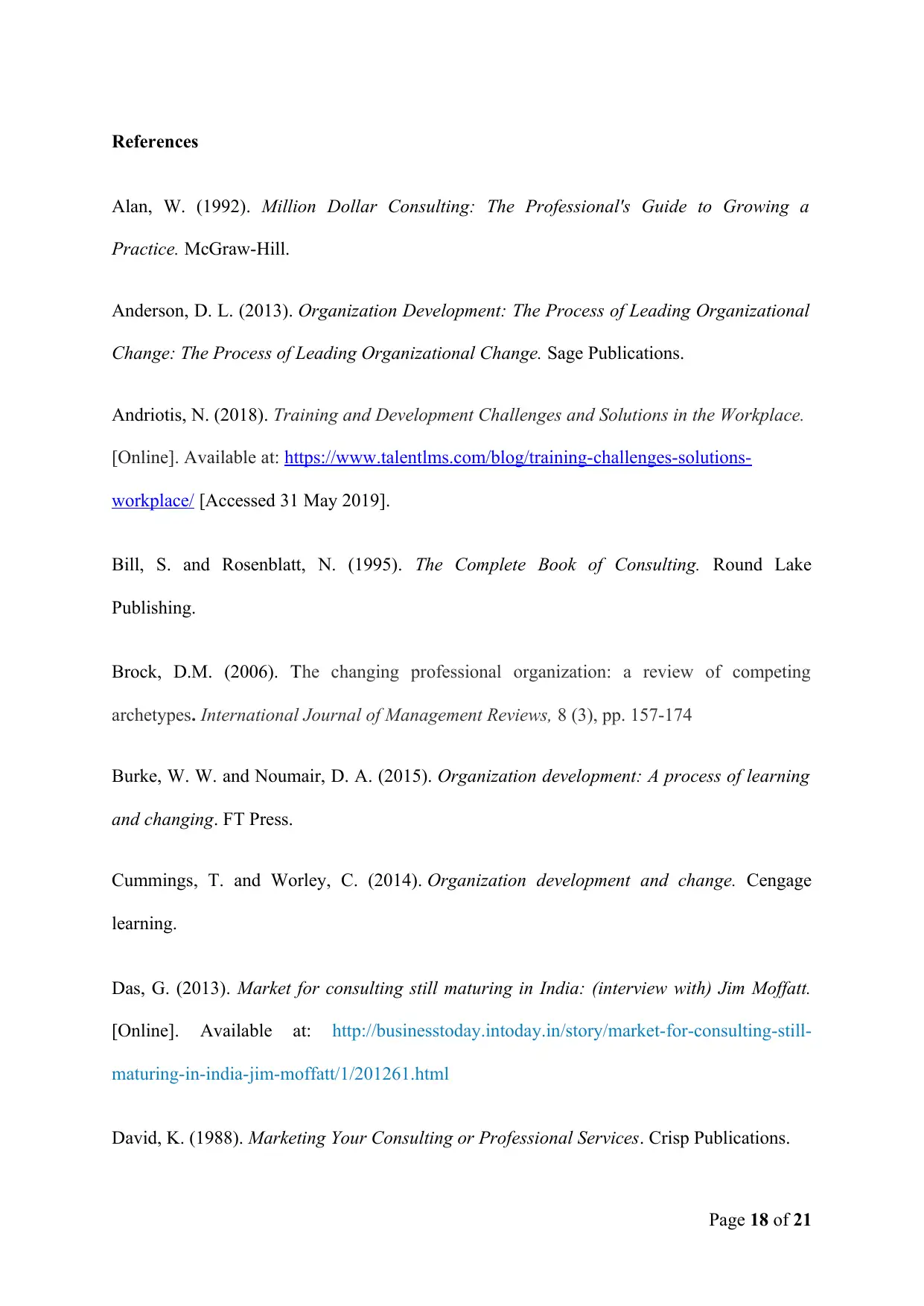
References
Alan, W. (1992). Million Dollar Consulting: The Professional's Guide to Growing a
Practice. McGraw-Hill.
Anderson, D. L. (2013). Organization Development: The Process of Leading Organizational
Change: The Process of Leading Organizational Change. Sage Publications.
Andriotis, N. (2018). Training and Development Challenges and Solutions in the Workplace.
[Online]. Available at: https://www.talentlms.com/blog/training-challenges-solutions-
workplace/ [Accessed 31 May 2019].
Bill, S. and Rosenblatt, N. (1995). The Complete Book of Consulting. Round Lake
Publishing.
Brock, D.M. (2006). The changing professional organization: a review of competing
archetypes. International Journal of Management Reviews, 8 (3), pp. 157-174
Burke, W. W. and Noumair, D. A. (2015). Organization development: A process of learning
and changing. FT Press.
Cummings, T. and Worley, C. (2014). Organization development and change. Cengage
learning.
Das, G. (2013). Market for consulting still maturing in India: (interview with) Jim Moffatt.
[Online]. Available at: http://businesstoday.intoday.in/story/market-for-consulting-still-
maturing-in-india-jim-moffatt/1/201261.html
David, K. (1988). Marketing Your Consulting or Professional Services. Crisp Publications.
Page 18 of 21
Alan, W. (1992). Million Dollar Consulting: The Professional's Guide to Growing a
Practice. McGraw-Hill.
Anderson, D. L. (2013). Organization Development: The Process of Leading Organizational
Change: The Process of Leading Organizational Change. Sage Publications.
Andriotis, N. (2018). Training and Development Challenges and Solutions in the Workplace.
[Online]. Available at: https://www.talentlms.com/blog/training-challenges-solutions-
workplace/ [Accessed 31 May 2019].
Bill, S. and Rosenblatt, N. (1995). The Complete Book of Consulting. Round Lake
Publishing.
Brock, D.M. (2006). The changing professional organization: a review of competing
archetypes. International Journal of Management Reviews, 8 (3), pp. 157-174
Burke, W. W. and Noumair, D. A. (2015). Organization development: A process of learning
and changing. FT Press.
Cummings, T. and Worley, C. (2014). Organization development and change. Cengage
learning.
Das, G. (2013). Market for consulting still maturing in India: (interview with) Jim Moffatt.
[Online]. Available at: http://businesstoday.intoday.in/story/market-for-consulting-still-
maturing-in-india-jim-moffatt/1/201261.html
David, K. (1988). Marketing Your Consulting or Professional Services. Crisp Publications.
Page 18 of 21

Dawson-Shepherd, A., Kellner, K. and Neumann, J. E. (2013). Developing organisational
consultancy. Routledge.
Fincham, R. and Seidl, M. D. (2013). Management consulting and uncertainty: mapping the
territory. International Studies of Management and Organization, 43 (3), pp. 3-10
Furusten, S. (2013). Commercialized professionalism on the field of management consulting.
Journal of Organizational Change Management, 26 (2), pp. 265-285
Hagenmeyer, U. (2010). Integrity in management consulting: a contradiction in terms? Sage.
Herman, H. (1997). Complete Guide to Consulting Contracts. Dear born.
Jensen, S. H., Poulfelt, F. and Kraus, S. (2010). Managerial routines in professional service
firms: transforming knowledge into competitive advantages. The Service Industries
Journal, 30 (12), pp. 2045-2062
Kerzner, H. (2013). Project Management Case Studies. John Wiley & Sons
Kipping, M. and Clark, T. (2012). The Oxford Handbook of Management Consulting. OUP
Oxford
Kipping, M. and Kirkpatrick, I. (2013). Alternative pathways of change in professional
services firms: the case of management consulting. Journal of Management Studies, 50 (5),
pp. 777-807
Maisel, L. and Cokins, G. (2013). Predictive Business Analytics: Forward Looking
Capabilities to Improve Business Performance. John Wiley & Sons
Maister, D. H. (1993). Managing the professional service firm. NY: Free Press
Page 19 of 21
consultancy. Routledge.
Fincham, R. and Seidl, M. D. (2013). Management consulting and uncertainty: mapping the
territory. International Studies of Management and Organization, 43 (3), pp. 3-10
Furusten, S. (2013). Commercialized professionalism on the field of management consulting.
Journal of Organizational Change Management, 26 (2), pp. 265-285
Hagenmeyer, U. (2010). Integrity in management consulting: a contradiction in terms? Sage.
Herman, H. (1997). Complete Guide to Consulting Contracts. Dear born.
Jensen, S. H., Poulfelt, F. and Kraus, S. (2010). Managerial routines in professional service
firms: transforming knowledge into competitive advantages. The Service Industries
Journal, 30 (12), pp. 2045-2062
Kerzner, H. (2013). Project Management Case Studies. John Wiley & Sons
Kipping, M. and Clark, T. (2012). The Oxford Handbook of Management Consulting. OUP
Oxford
Kipping, M. and Kirkpatrick, I. (2013). Alternative pathways of change in professional
services firms: the case of management consulting. Journal of Management Studies, 50 (5),
pp. 777-807
Maisel, L. and Cokins, G. (2013). Predictive Business Analytics: Forward Looking
Capabilities to Improve Business Performance. John Wiley & Sons
Maister, D. H. (1993). Managing the professional service firm. NY: Free Press
Page 19 of 21
Paraphrase This Document
Need a fresh take? Get an instant paraphrase of this document with our AI Paraphraser
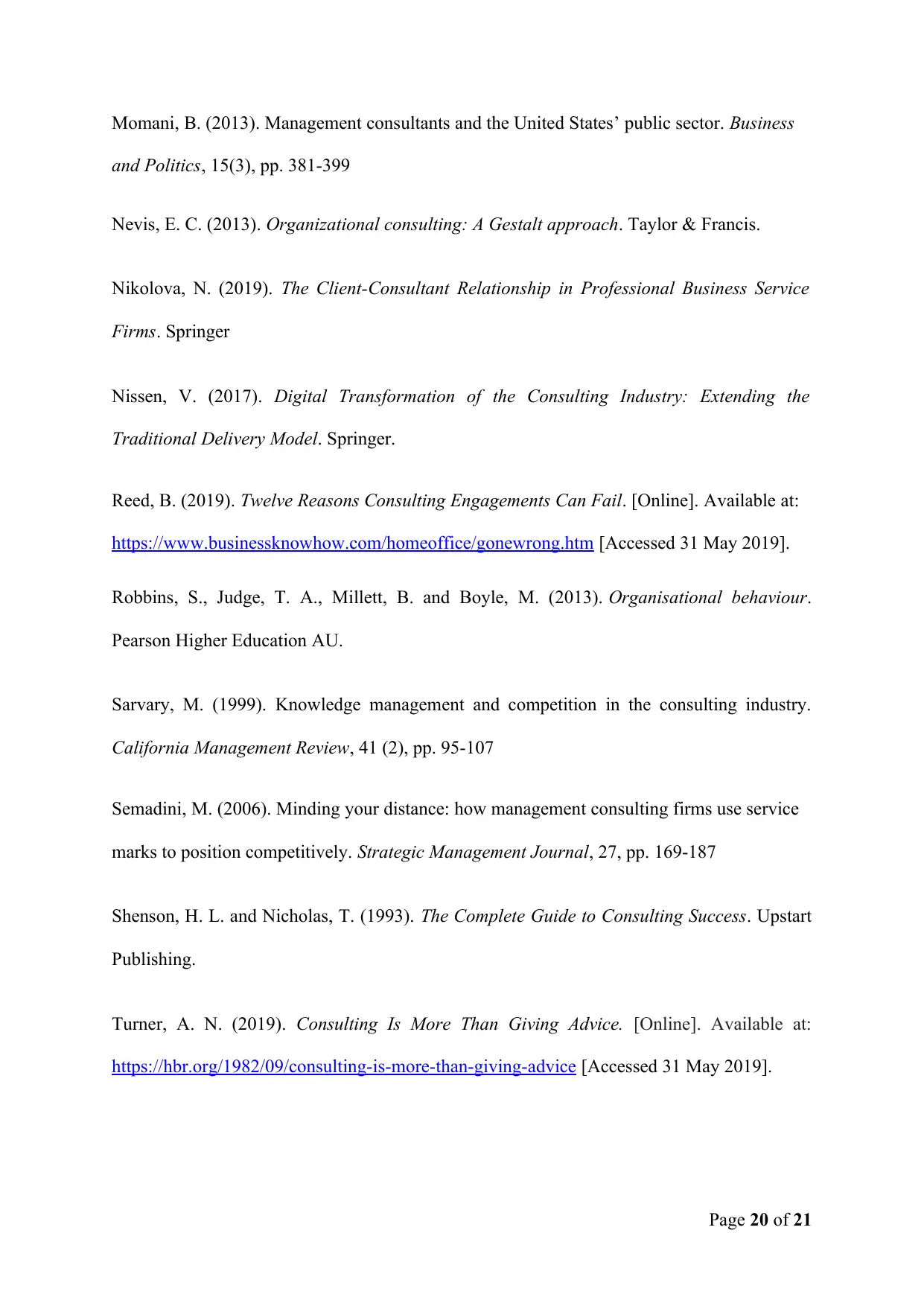
Momani, B. (2013). Management consultants and the United States’ public sector. Business
and Politics, 15(3), pp. 381-399
Nevis, E. C. (2013). Organizational consulting: A Gestalt approach. Taylor & Francis.
Nikolova, N. (2019). The Client-Consultant Relationship in Professional Business Service
Firms. Springer
Nissen, V. (2017). Digital Transformation of the Consulting Industry: Extending the
Traditional Delivery Model. Springer.
Reed, B. (2019). Twelve Reasons Consulting Engagements Can Fail. [Online]. Available at:
https://www.businessknowhow.com/homeoffice/gonewrong.htm [Accessed 31 May 2019].
Robbins, S., Judge, T. A., Millett, B. and Boyle, M. (2013). Organisational behaviour.
Pearson Higher Education AU.
Sarvary, M. (1999). Knowledge management and competition in the consulting industry.
California Management Review, 41 (2), pp. 95-107
Semadini, M. (2006). Minding your distance: how management consulting firms use service
marks to position competitively. Strategic Management Journal, 27, pp. 169-187
Shenson, H. L. and Nicholas, T. (1993). The Complete Guide to Consulting Success. Upstart
Publishing.
Turner, A. N. (2019). Consulting Is More Than Giving Advice. [Online]. Available at:
https://hbr.org/1982/09/consulting-is-more-than-giving-advice [Accessed 31 May 2019].
Page 20 of 21
and Politics, 15(3), pp. 381-399
Nevis, E. C. (2013). Organizational consulting: A Gestalt approach. Taylor & Francis.
Nikolova, N. (2019). The Client-Consultant Relationship in Professional Business Service
Firms. Springer
Nissen, V. (2017). Digital Transformation of the Consulting Industry: Extending the
Traditional Delivery Model. Springer.
Reed, B. (2019). Twelve Reasons Consulting Engagements Can Fail. [Online]. Available at:
https://www.businessknowhow.com/homeoffice/gonewrong.htm [Accessed 31 May 2019].
Robbins, S., Judge, T. A., Millett, B. and Boyle, M. (2013). Organisational behaviour.
Pearson Higher Education AU.
Sarvary, M. (1999). Knowledge management and competition in the consulting industry.
California Management Review, 41 (2), pp. 95-107
Semadini, M. (2006). Minding your distance: how management consulting firms use service
marks to position competitively. Strategic Management Journal, 27, pp. 169-187
Shenson, H. L. and Nicholas, T. (1993). The Complete Guide to Consulting Success. Upstart
Publishing.
Turner, A. N. (2019). Consulting Is More Than Giving Advice. [Online]. Available at:
https://hbr.org/1982/09/consulting-is-more-than-giving-advice [Accessed 31 May 2019].
Page 20 of 21
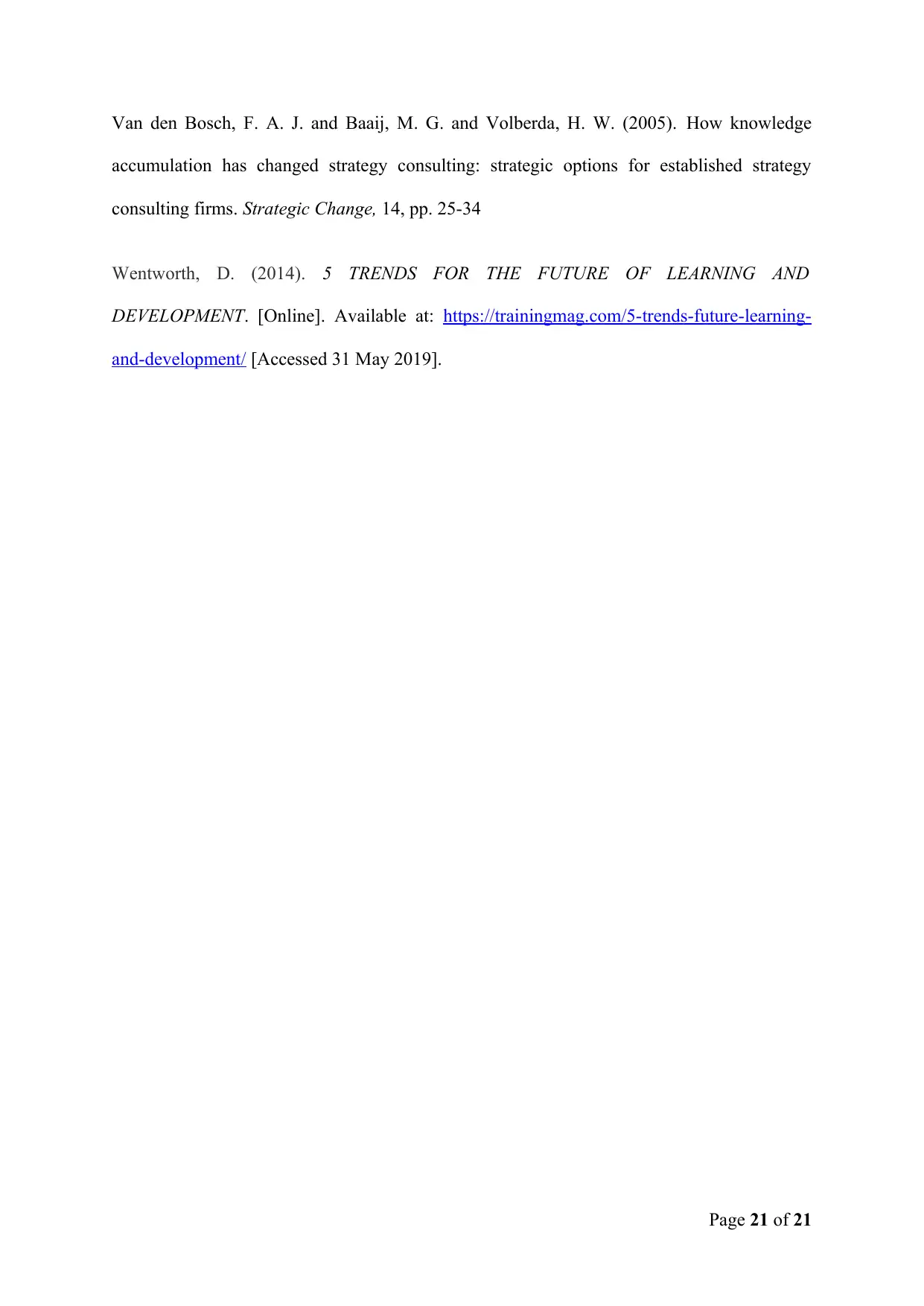
Van den Bosch, F. A. J. and Baaij, M. G. and Volberda, H. W. (2005). How knowledge
accumulation has changed strategy consulting: strategic options for established strategy
consulting firms. Strategic Change, 14, pp. 25-34
Wentworth, D. (2014). 5 TRENDS FOR THE FUTURE OF LEARNING AND
DEVELOPMENT. [Online]. Available at: https://trainingmag.com/5-trends-future-learning-
and-development/ [Accessed 31 May 2019].
Page 21 of 21
accumulation has changed strategy consulting: strategic options for established strategy
consulting firms. Strategic Change, 14, pp. 25-34
Wentworth, D. (2014). 5 TRENDS FOR THE FUTURE OF LEARNING AND
DEVELOPMENT. [Online]. Available at: https://trainingmag.com/5-trends-future-learning-
and-development/ [Accessed 31 May 2019].
Page 21 of 21
1 out of 21
Your All-in-One AI-Powered Toolkit for Academic Success.
+13062052269
info@desklib.com
Available 24*7 on WhatsApp / Email
![[object Object]](/_next/static/media/star-bottom.7253800d.svg)
Unlock your academic potential
© 2024 | Zucol Services PVT LTD | All rights reserved.
